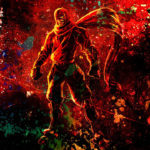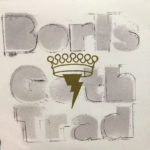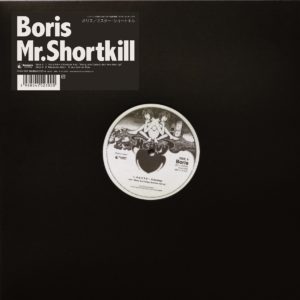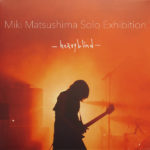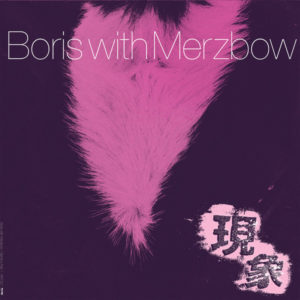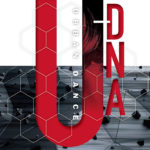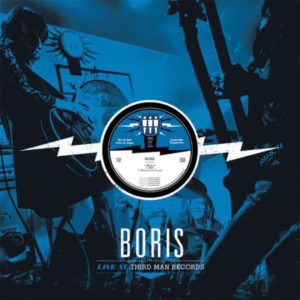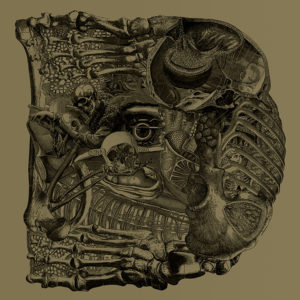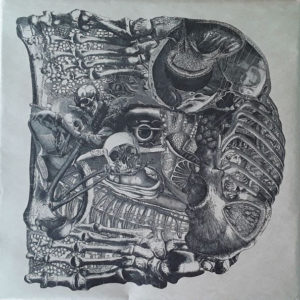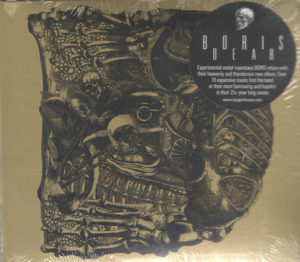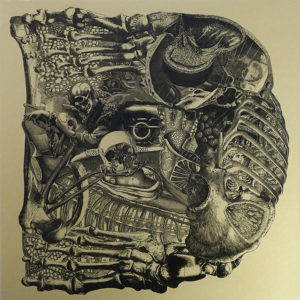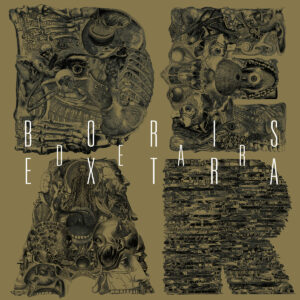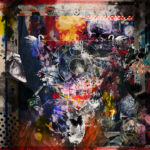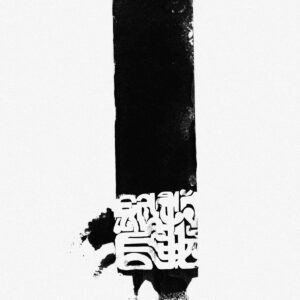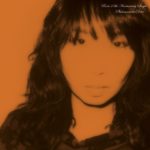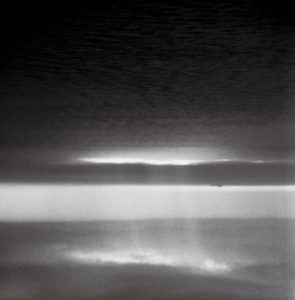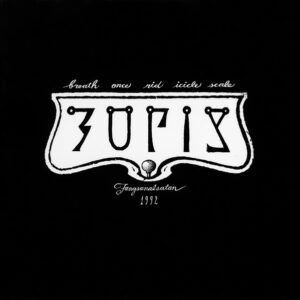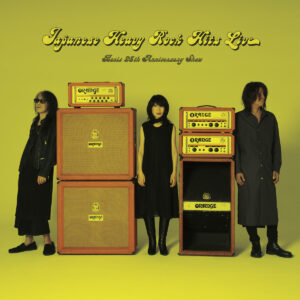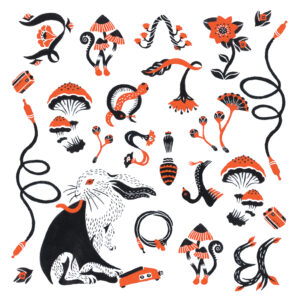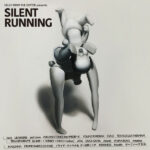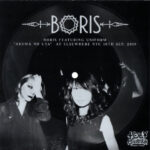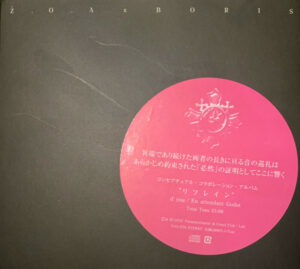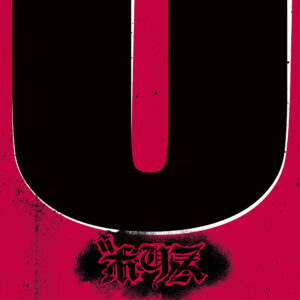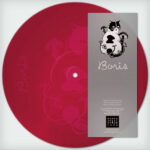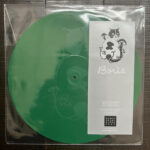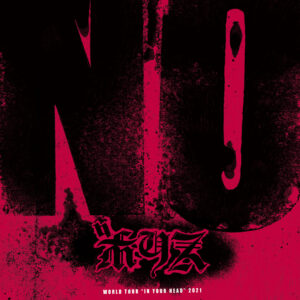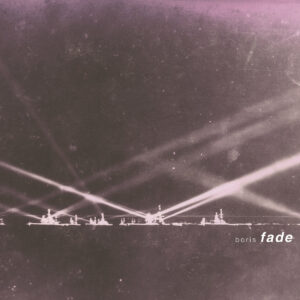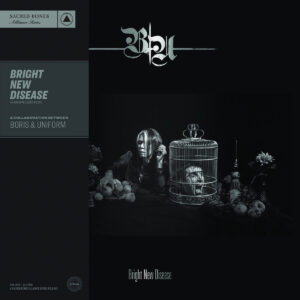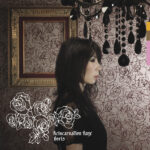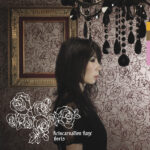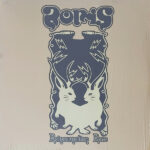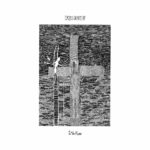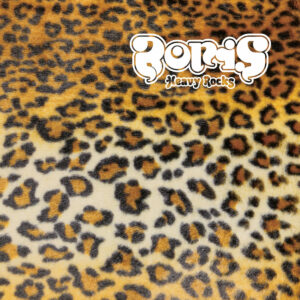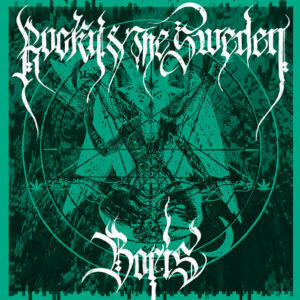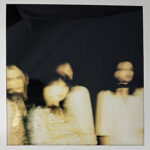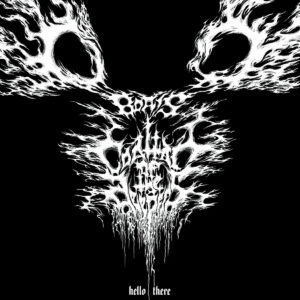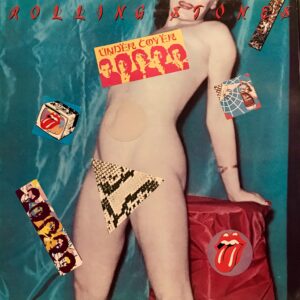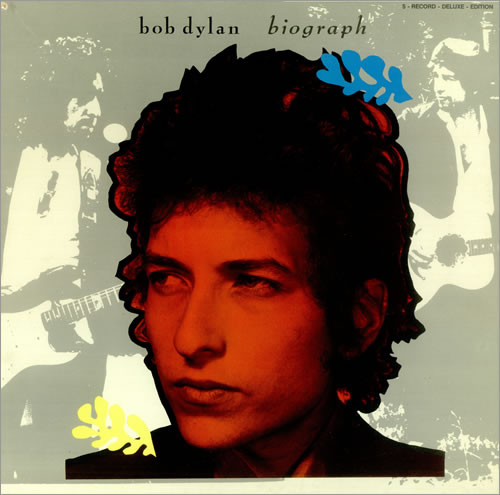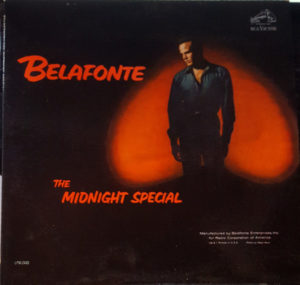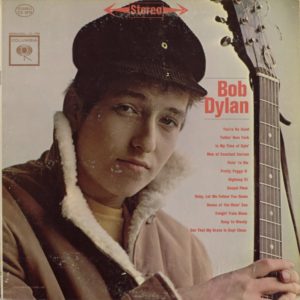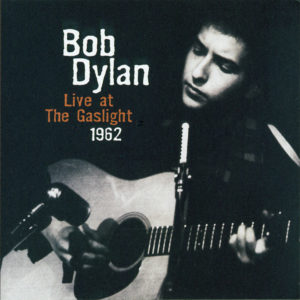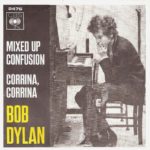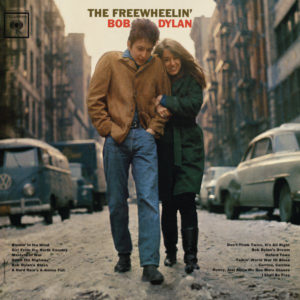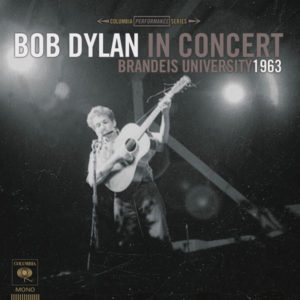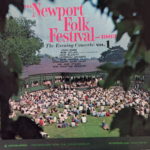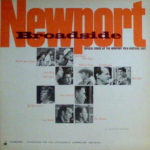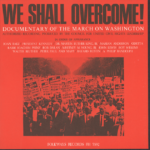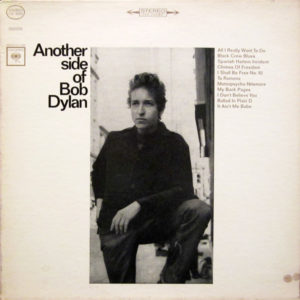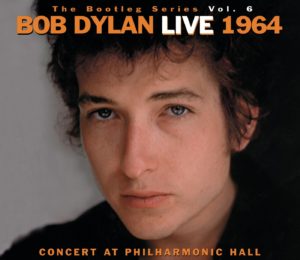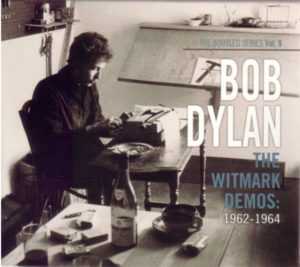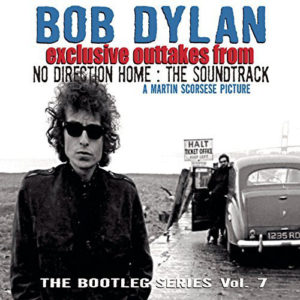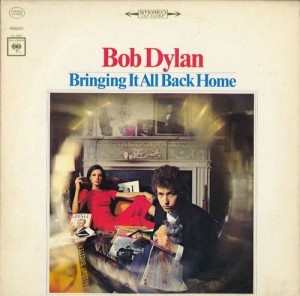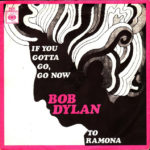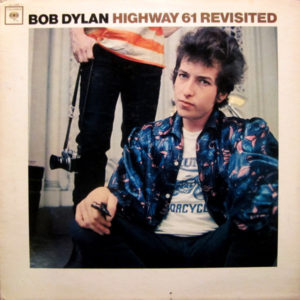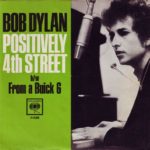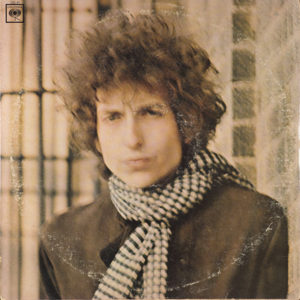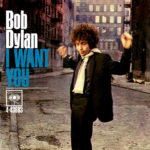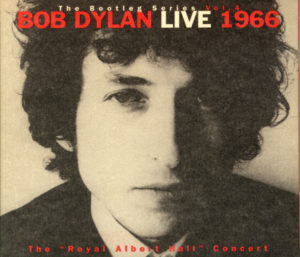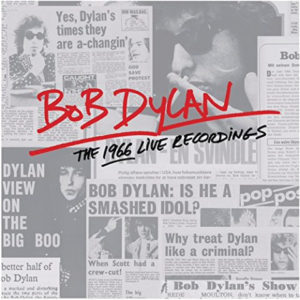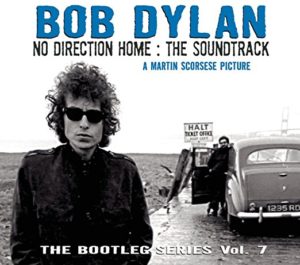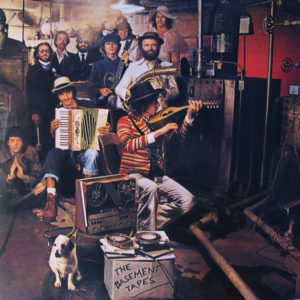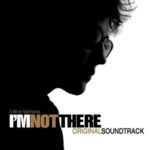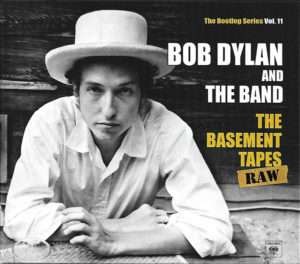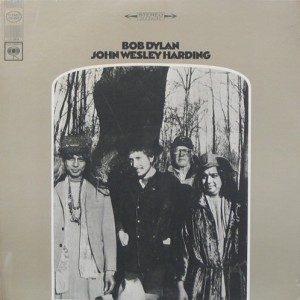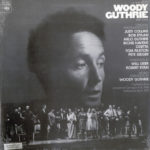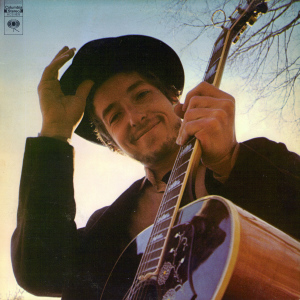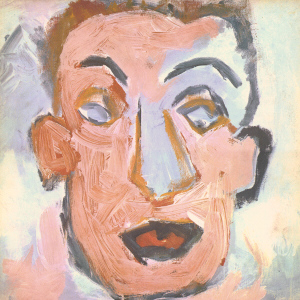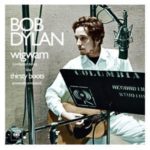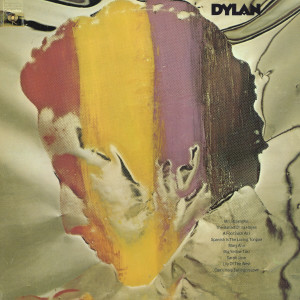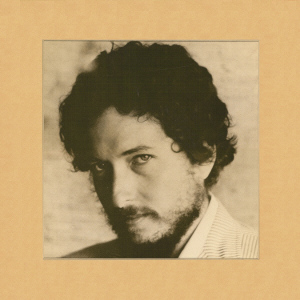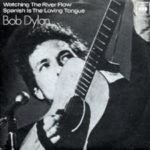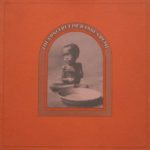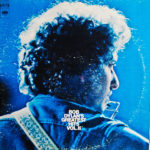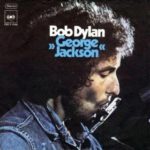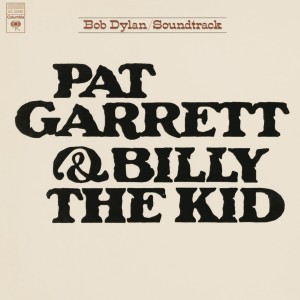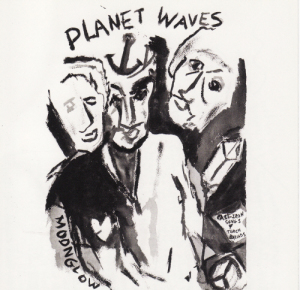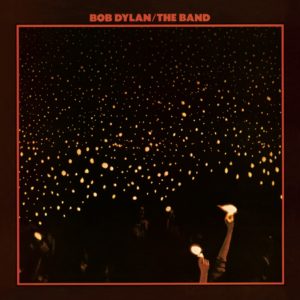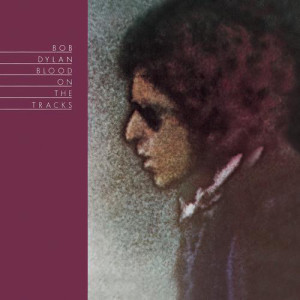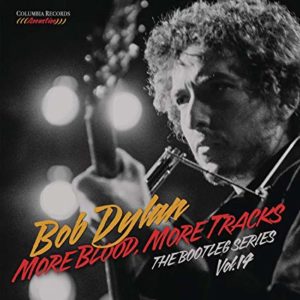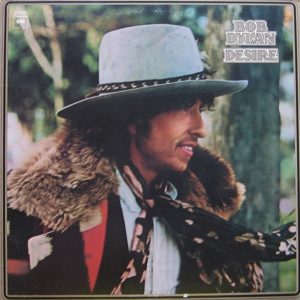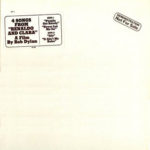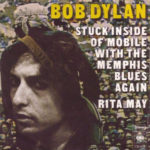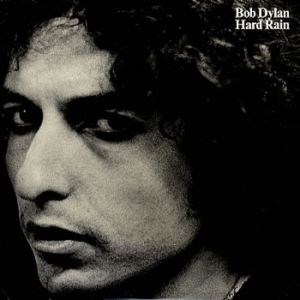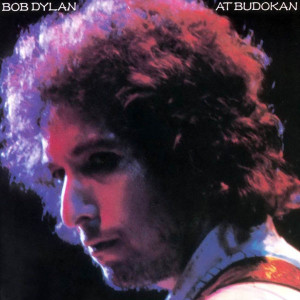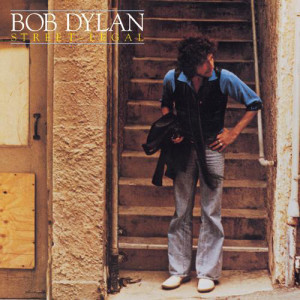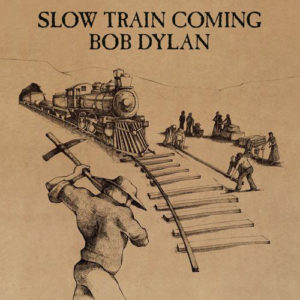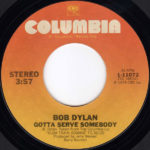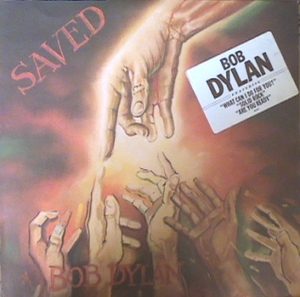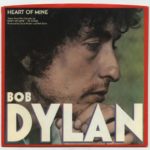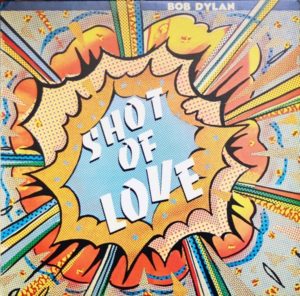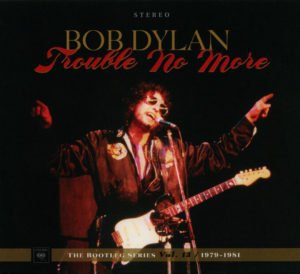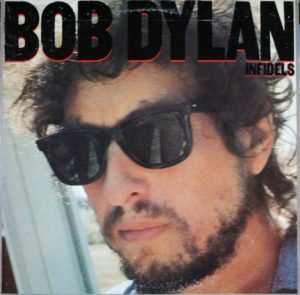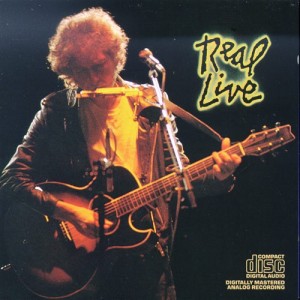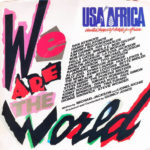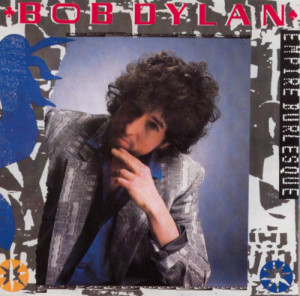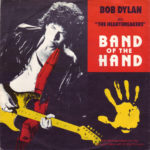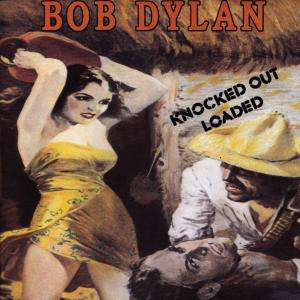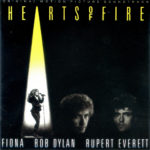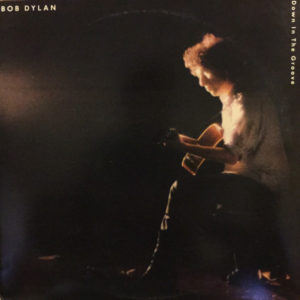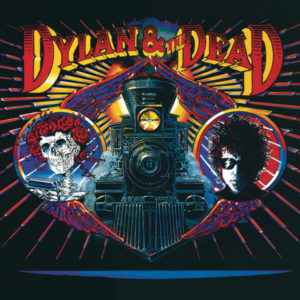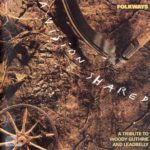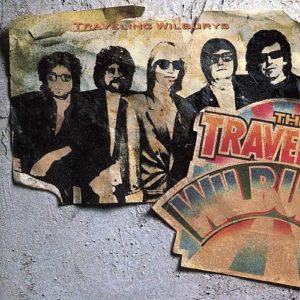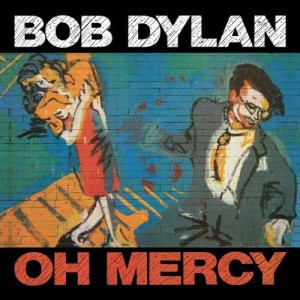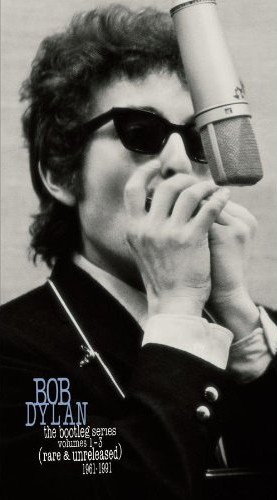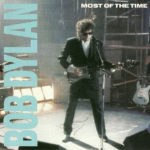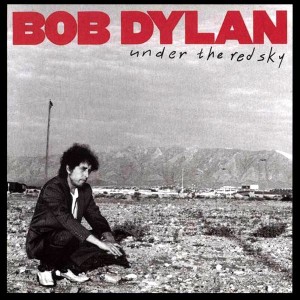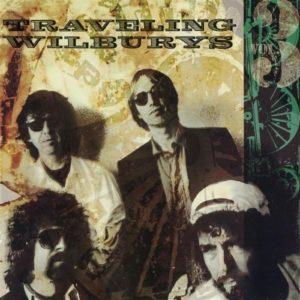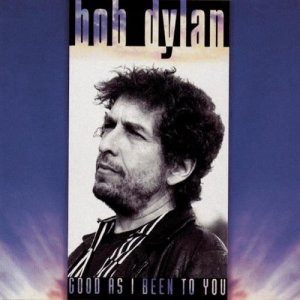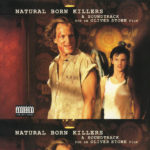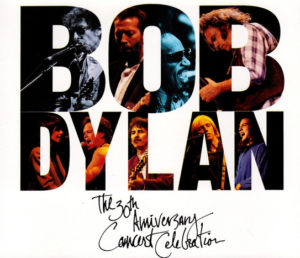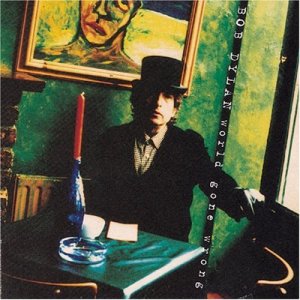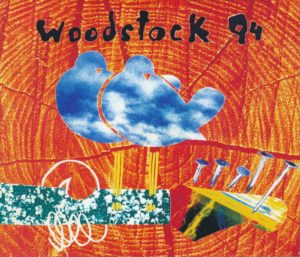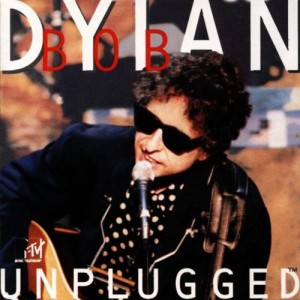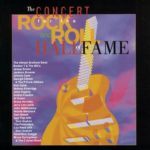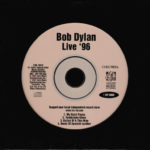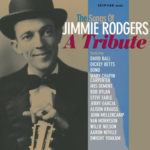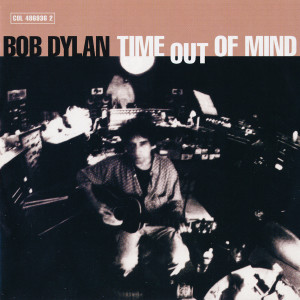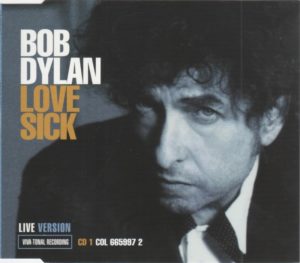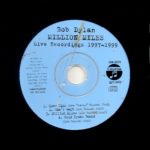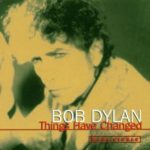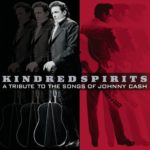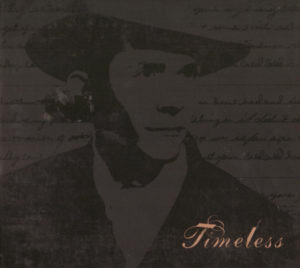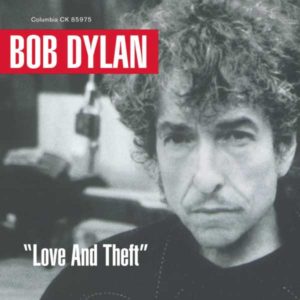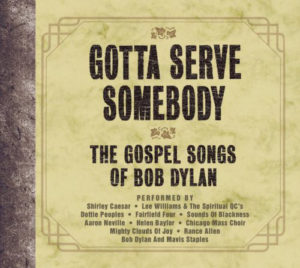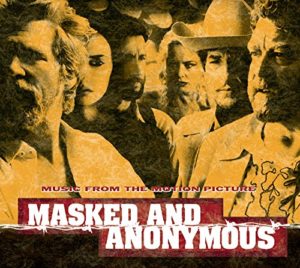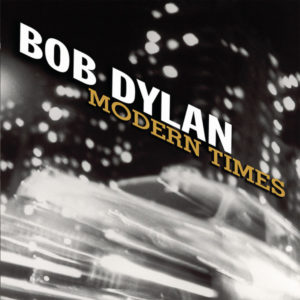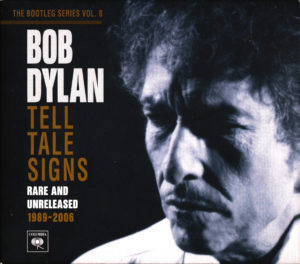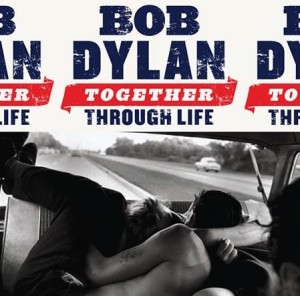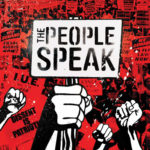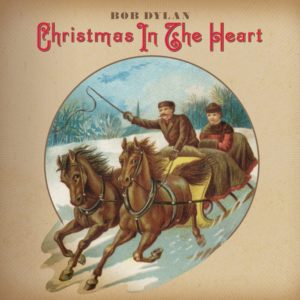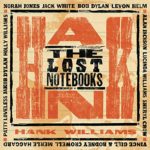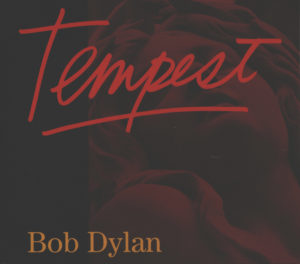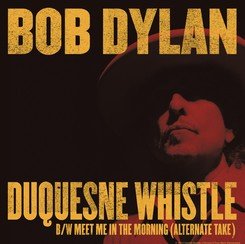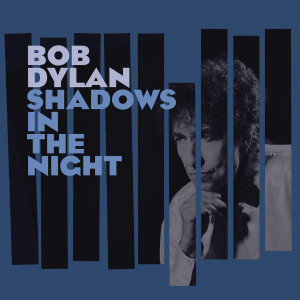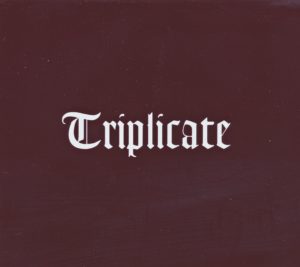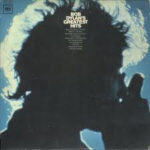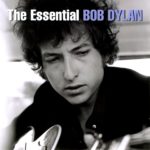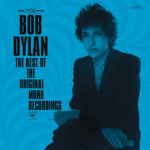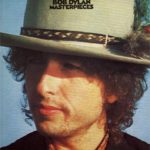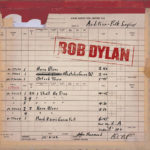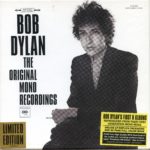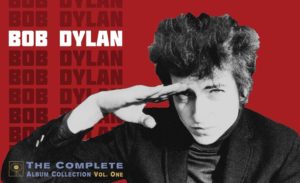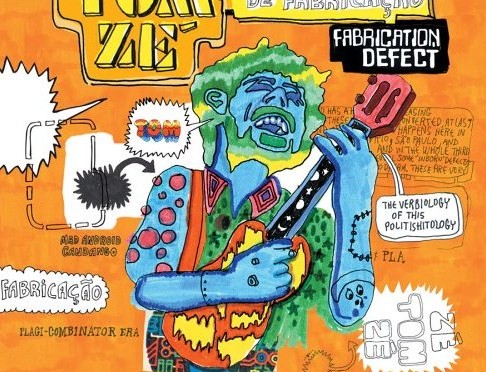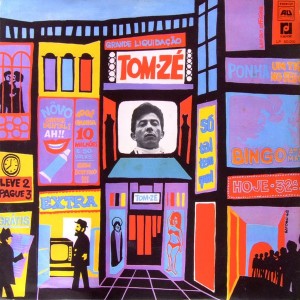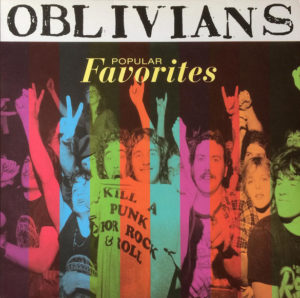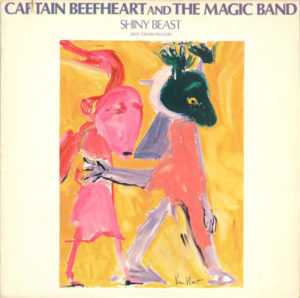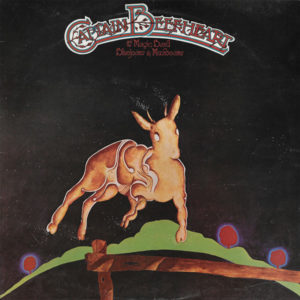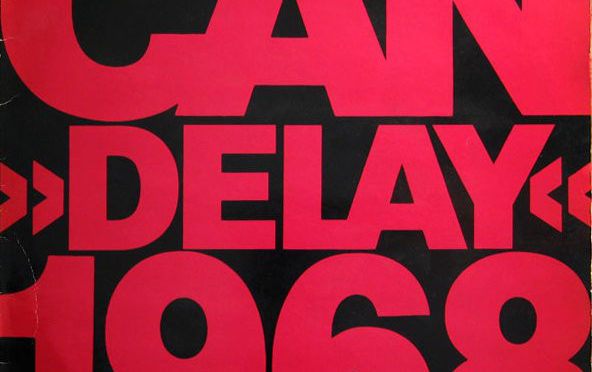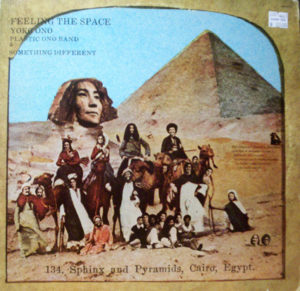Under Construction! – This has a way to go before it’s complete, but it’s getting there slowly.
Born: May 24, 1941, Duluth, MN, United States
Currently: Malibu, CA, United States
Birth Name: Robert Allen Zimmerman
Also known as/noms des plumes: Jack Frost, Blind Boy Grunt, Lucky Wilbury, Boo Wilbury
See also Quick Guide to Recommended Bob Dylan Releases
A General Take on the Music of Bob Dylan
The entire face of popular music changed with Bob Dylan. He is the name most commonly cited as leading the transition of rock and pop music to more serious and adult-oriented themes. He helped garner respect for rock and pop music as legitimate art, capable of appreciation the way any artwork in the Louvre might. Most critics focus on this poetic lyrics and songwriting, though others, and Dylan himself, view him as principally a live performer. Dylan was one of the first post-Elvis rock stars, though unlike The Beatles or The Rolling Stones he was not part of a regular band. Instead he started out as another solo artist as part of the urban folk movement, making a name for himself in New York City in the early 1960s. By the mid-60s he had branched out to rock and roll. His first concerts using electric guitars prompted divided reactions, with many in the folk scene expressing hostility while at the same time he garnered the attention of more and more new fans. Stardom didn’t always seem to suit him, and Dylan’s sometimes erratic behavior often seemed driven by a desire to escape public scrutiny and preserve some kind of private personal life — though in the end Dylan always chose the riches of celebrity life over true seclusion. Over his many-decade career, Dylan’s music has gone through a variety of periods and associated styles, from arena rock to Vegas glitz to preachy gospel to slick pop to blues revival to atmospheric rock. His career hit some low points in the 1980s. Since 1988 he has toured almost continuously, something dubbed his “Never Ending Tour.” He enjoyed a critical and popular resurgence in the late 1990s.
This guide is intended to provide an introduction to the recordings of Bob Dylan. There is a “tier” system to point newcomers to the most essential material (see the legend below). However, this list is meant to be fairly comprehensive, so bear in mind that much of the material listed will be of interest primarily to listeners who have heard most of the catalog already. Bootlegs have been omitted, as have Dylan’s guest appearances on other artists’ works (with a few select exceptions to that rule). Each entry has at least one recommended track, so that listeners who prefer to buy digital downloads can focus on the better tracks first and decide from there what else they want. This list is organized chronologically by recording date, so recordings are frequently listed in an order different from their original order of release.
How Many Roads Must a Man Walk Down?: The Folk Years
Dylan grew up in Minnesota, and briefly attended college at the University of Minnesota in Minneapolis. He left school and relocated to New York City where he enmeshed himself in the burgeoning early 1960s urban folk movement. He legally changed his name from Robert Zimmerman to Bob Dylan in 1962. He garnered respect as a songwriter, though he initially struggled to secure a recording deal. He was turned down by Folkways Records, before being given a chance to record for Columbia Records. His biggest break came from an appearance at the 1963 Newport Folk Festival, at which he appeared thanks to his personal and professional association with Joan Baez. Dylan’s music during this early period was almost entirely acoustic and in the folk tradition, though his songwriting exhibited increasingly modern tendencies as time when on.
Release Notes:
Recorded:
Producer(s):
Tier:
Key Track(s):
Review:

Release Notes: “Midnight Special” available on Folk Standards
Recorded: November 1961.
Producer(s): Hugo Montenegro
Tier:
Key Track(s): “The Midnight Special”
Review:
Although this list generally omits Dylan’s guest appearances, his very first professional recordings were to play harmonica for others, including his first recording session for Carolyn Hester‘s Carolyn Hester, and the title track of Harry Belafonte’s The Midnight Special, a song popularized by Lead Belly (in Chronicles, Vol. 1 Dylan inaccurately states that the Belafonte session was his very first).

Release Notes:
Recorded: Columbia Studios, New York, NY, November 20 and 22, 1961
Producer(s): John Hammond
Tier: Enjoyable
Key Track(s): “In My Time of Dyin’,” “Song to Woody”
Review:
Bob Dylan’s self-titled debut album sold modestly (if not outright poorly) on release and squarely fit into the then-current urban folk revival movement. All but two songs are traditional folk and blues tunes. Dylan had taken up visiting a sick and dying Woody Guthrie, and wrote “Song to Woody” for him (it borrows from Guthrie’s “1913 Massacre” among other sources). Much of this is in the spirit of the music of Guthrie. Although many people ignore this because it doesn’t feature much in the way of Dylan’s much-revered songwriting, it’s actually a very well-constructed album full of excellent song choices and more dedicated and practiced performances than on some other early Dylan albums. So while this doesn’t break any new ground, it’s still a very good conventional folk album. If you like this, the high-quality bootleg Live in Minneapolis: Bonnie Beecher’s Apartment 22/12/1961 recorded the following month is worth your time.

Release Notes:
Recorded: The Gaslight, New York, NY, October 1962
Producer(s): Jeff Rosen and Steve Berkowitz
Tier: For completists only
Key Track(s): “Rocks and Gravel,” “John Brown,” “Barbara Allen”
Review:
Originally released through a deal with the Starbucks Corporation, their exclusive CD release culled tracks from an October 1962 performance at the Greenwich Village nightspot The Gaslight. Many of the songs from this collection of recordings have been released elsewhere officially and in bootleg form, so this CD is far from a complete documentation of these shows. The performances give a great insight into Dylan’s track selection and performance style at the beginning of his career. A few early staples appear here in the form of “A Hard Rain’s A-Gonna Fall” and “Don’t Think Twice, It’s Alright.” Other than that, we find Dylan working through a collection of traditional folk tunes. Notably, this collection includes the first officially released 1960s performance of “John Brown,” one of his great, previously unreleased, and self-penned anti-war tunes from the period. Because of the abundance of traditional tunes, this nice set is definitely geared toward fans with an established acquaintance with Dylan’s discography.

Release Notes: A-side available on Biograph and Side Tracks; B-side is not the same version as on The Freewheelin’ Bob Dylan
Recorded: Columbia Recording Studios, New York, NY, October 26 and November 14, 1962
Producer(s): John Hammond
Tier:
Key Track(s):
Review:

Release Notes: There are incredibly rare and valuable versions of The Freewheelin’ Bob Dylan that feature a substantially different track listing. These versions substitute the songs “Rocks and Gravel,” “Let Me Die in My Footsteps,” “Gamblin’ Willie’s Dead Man’s Hand,” and “Talkin’ John Birch Blues” in place of “Girl from the North Country,” “Masters of War,” “Bob Dylan’s Dream,” and “Talkin’ World War III Blues.” Non-promotional stereo copies of this LP have reportedly sold for upwards of $35,000, making it a contender for the most valuable vinyl record ever released.
Recorded: Columbia Records Studio A, New York, NY, April 24–25, July 9, October 26, November 1 and 15, December 6, 1962; and April 24, 1963
Producer(s): John Hammond, Tom Wilson
Tier: Enjoyable
Key Track(s): “Girl From the North Country,” “Don’t Think Twice, It’s Alright,” “A Hard Rain’s A-Gonna Fall”
Review:
Of Dylan’s early career “folk” albums, The Freewheelin’ Bob Dylan tends to be a favorite of fans and critics alike. Though it’s a good one, it is still one of the more overrated albums in his catalog. Unlike his debut it focuses on his songwriting, which many point to as his greatest artistic strength. Most appealing to many is also the tendency toward dreamy, romanticized themes. But apart from unveiling some undeniably landmark compositions like “Blowin’ in the Wind,” Dylan’s performances here are somewhat tentative at times and the album feels very uneven.

Release Notes: available as a bonus with The Bootleg Series Vol. 9: The Witmark Demos: 1962-1964 and The Original Mono Recordings at an online retailer
Recorded: Brandeis University, Waltham, MA, May 10, 1963
Producer(s):
Tier: For completists only
Key Track: “Ballad of Hollis Brown”
Review:
This exclusive release from amazon.com came with copies of The Bootleg Series Vol. 9: The Witmark Demos: 1962-1964 and The Original Mono Recordings. The previously unreleased — not even in bootleg form — show, recorded May 10, 1963 at the traditionally Jewish Brandeis University in Waltham, Massachusetts features six songs that appear in better form on other releases (along with an incomplete take of “Honey, Just Allow Me One More Chance”). The track selection, though, gives an interesting look at what his shows were like prior to popularity of Peter, Paul & Mary‘s rendition of “Blowin’ in the Wind,” which became a smash hit within two months of this show. The set consists mainly of talking blues and a few of his more notable “protest” songs (including “Ballad of Hollis Brown,” which would later appear on Dylan’s then-unreleased The Times They Are A-Changin’). As a result, he comes off as less than serious, even unintentionally comical. The sound quality is decent, but the results are merely serviceable.

Release Notes:
Recorded: Newport Folk Festival, Newport, RI, July 26, 1963
Producer(s):
Tier:
Key Track(s): “Blowin’ in the Wind”
Review:

Release Notes:
Recorded: Newport Folk Festival, Newport, RI, July 27 and 28, 1963
Producer(s):
Tier:
Key Track(s):
Review:

Release Notes: This Folkways release contains overdubs over Dylan’s performance
Recorded: March on Washington for Jobs and Freedom, Lincoln Memorial, Washington, DC, August 28, 1963
Producer(s):
Tier: For completists only
Key Track(s): “Ballad of Medgar Evers”
Review:

Release Notes: promotional only; additional songs from the same concert were previously released on The Bootleg Series Volumes 1-3: (Rare & Unreleased) 1961-1991 and The Bootleg Series Vol. 7: No Direction Home: The Soundtrack; these recordings were originally slated to be on a live full-length album shortly after being recorded, but that album was canceled by Columbia Records and never released
Recorded: Carnegie Hall, New York, NY, October 26, 1963
Producer(s):
Tier:
Key Track(s):
Review:

Release Notes:
Recorded: Columbia Studio A, New York, NY, August 6, 7 and 12, and October 23, 24 and 31, 1963
Producer(s): Tom Wilson
Tier: Highly recommended
Key Track(s): “The Times They Are A-Changin’,” “With God on Our Side,” “Only a Pawn in Their Game,” “Ballad of Hollis Brown,” “The Lonesome Death of Hattie Carroll”
Review:
With a much more dark and serious tone than his last album, The Times They Are A-Changin’ is (in retrospect) one of Bob Dylan’s most overlooked albums. His performances are consistently effective and come across as more accomplished than the often undisciplined and sloppy The Freewheelin’ Bob Dylan. It’s interesting too how already Dylan in his songwriting was reworking material of others and himself, with “Restless Farewell” borrowing the melody from the Irish folk song “The Parting Glass,” “Boots of Spanish Leather” reusing the melody of “Girl from the North Country” and other songs drawing a variety of influences from Irish and Scottish folk music. It is unfair to dismiss this as a “finger pointin'” folk protest album and move on because the songs really aren’t preachy and reveal nuanced views of complex sociological issues. The intense performances are among the most effective of Dylan’s early years.

Release Notes:
Recorded: Columbia Studio A, New York, NY, June 9, 1964
Producer: Tom Wilson
Tier: Highly recommended
Key Tracks: “Chimes of Freedom,” “My Back Pages,” “It Ain’t Me Babe”
Review:
Another Side of Bob Dylan is the strangest of his LPs released before his 1966 motorcycle accident. It was recorded in one single late night wine-fueled session, most likely contributing to its haphazard form. It is also Dylan’s studio last album until 1992’s Good As I Been to You to feature him as a solo performer. There are many things to both like and loathe about it. It features at least three of his most dazzling songs to date in the tender “To Ramona,” the prophetic “My Back Pages,” and the vicious “It Ain’t Me Babe.” It also features three of his most forgettable songs of the era in “Black Crow Blues,” “Spanish Harlem Incident,” and the funny-only-on-first-listen “I Shall Be Free No. 10.” Despite these inconsistencies, this is easily Dylan’s most pop-oriented album to this point, one that clearly shows him breaking with his more direct and topical form of lyrical protest. Given the serious tone and lyrical content of his previous two albums, Another Side reveals much more of the comedian in Dylan, especially on the opener “All I Really Want to Do” and the hilarious “Motorpsycho Nitemare,” which illustrates his extensive grasp (and appreciation) of popular culture. He can also be especially mournful, as he is on “Ballad in Plain D,” which, because of its naked honesty, is nearly unlistenable. “My Back Pages” might be the most important song on the album, as it foreshadows future masterpieces like “It’s Alight, Ma (I’m Only Bleeding)” and “Gates of Eden.” However, the highlight for most listeners is the closer, “It Ain’t Me Babe.” On this performance, Dylan instantly transforms himself from folk troubadour to pop king, churning out a song brutally frank in its rejection of romantic projection in relationships. Though Another Side is undoubtedly the most sloppily performed of his 1960s LPs, the spontaneous feel of the recording–more often resembling a documentary than a fully conceived album — as well as the transitional nature of Dylan’s compositions here, makes it one of his most insightful collections to date.

Release Notes:
Recorded: Philharmonic Hall, New York, NY, October 31, 1964
Producer(s): Jeff Rosen and Steve Berkowitz
Tier:
Key Track(s):
Review:

Release Notes:
Recorded: 1962-1964
Produced for reissue by Jeff Rosen and Steve Berkowitz
Tier: For completists only
Key Tracks: “Tomorrow is a Long Time,” “Farewell,” “Boots of Spanish Leather”
Review:
Bob Dylan’s important group of releases, The Bootleg Series, reveal just how much great stuff he has written over the years. Much of this material, which he has essentially cast off, is some of the best music ever recorded. Now, with the exception of Vol. 7 of the series (“No Direction Home“), these sets have been of equal value to Dylan aficionados as well as general fans in need of damned good music. With Vol. 9, The Witmark Demos, we get a set geared exclusively toward the Dylanologists. Not that the material isn’t great: it’s just that much of this material has already been released with far better, available variations. Of the songs that have seen some official release before, the only three that surpass previously released versions include a somber, driving take of the anti-war track “John Brown,” a more insistent take of “Hard Times in New York Town,” and an absolutely spine-tingling rendition of “Boots of Spanish Leather.” Still, there are a quite a few good songs that people with a few Dylan bootlegs should already be familiar with. It’s great to hear such wonderful songs as “All Over You” (possibly Dylan’s filthiest lyric), the timeless yet topical track “The Death of Emmett Till,” the haunting “Long Time Gone,” and the lovely “Farewell” in decent fidelity, at least for what are nearly fifty year-old demos, played at the proper speed. The rest of the material on this set simply does not stack up to either the officially released LP versions or the variations that appear on other volumes of The Bootleg Series. Many are filled with flubs, misremembered lyrics, false starts, and other things that generally make listening to demos a problematic experience in general. We appreciate the rawness, yes, but sometimes to the detriment of the material.

Release Notes:
Recorded: Columbia Records Studio A, New York, NY, April 25, 1962, Newport Folk Festival, Newport, RI, July 26, 1964; Columbia Studio A, New York, NY, January 13, 1965
Producer(s): Tom Wilson, possibly John Hammond and others?
Tier:
Key Track(s):
Review:
Beatnik Rocker: Going Electric, Fame & Fortune
In 1965 Bob Dylan made a transition from being an acoustic folk performer to playing electrified rock and roll. The change provoked outrage from some in the folk scene, most famously at Dylan’s July 1965 appearance at the Newport Folk Festival. However, Dylan going electric coincided with a decline in the popularity of folk music and soaring popularity of rock music. With the release of Bringing It All Back Home and Highway 61 Revisited, he was catapulted to superstardom. As evidenced from video interviews of the period, the young Dylan did not quite know how to react to his sudden fame, and as a result his behavior could be erratic. Dylan had been hanging around with all the usual New York celebrities, like Andy Warhol‘s Factory crowd, but he eventually developed his own entourage. With his enormous success in 1965, Dylan became arguably the most influential pop musician of the day, with his work influencing the likes of The Beatles on Rubber Soul and inspiring a general trend toward more mature and complex statements in rock music.
In 1965 he married his first wife Sara Lownds. He lived in Woodstock, New York at that time, but eventually the couple relocated to New York City (and later to California). Dylan held a major tour of the United Kingdom, but then in July of 1966, not long after completion of the recording sessions for Blonde on Blonde, was involved in a motorcycle crash near his home in Woodstock. A lot of mystery surrounds the motorcycle crash and the extent of the injuries, if any, that Dylan suffered. In any event, the motorcycle crash prompted a halt to Dylan’s touring for many years, and it led to a period of relative seclusion. Dylan was recording primarily in Nashville, Tennessee in the late 1960s, rather than in New York as he had done for all of his earlier recordings.

Release Notes:
Recorded: Columbia Studio A, New York, NY, January 13-15, 1965
Producer(s): Tom Wilson
Tier: Essential
Key Track(s): “Mr. Tambourine Man,” “It’s Alright, Ma (I’m Only Bleeding),” “Subterranean Homesick Blues”
Review:
Bringing It All Back Home was Dylan’s first foray into recording rock music. Some point to changes in his songwriting on Another Side of Bob Dylan as leading in that direction, but this was where he launched into an electric sound — on side one at least. On side two, the music is linked more to the kind of folk music Dylan had done before. It is a bit perplexing that there was so much fuss about Dylan “going electric” at live performances that followed this album. Anyone paying attention should have known that he had already started to play rock music.
The apocalyptic tone poem “It’s Alright, Ma (I’m Only Bleeding)” furthers what had begun on earlier recordings like “A Hard Rain’s A-Gonna Fall.” It takes influence from the distancing effects of Bertolt Brecht‘s lyrics to songs like “Seeräuberjenny [Pirate Jenny]” (from Die Dreigroschenoper [The Threepenny Opera]), as well as the uniquely American angst of Beat writer Allen Ginsberg‘s poetry like “Howl”. The song is evidence of Dylan’s continued and growing interest in songwriting with a more individualistic perspective than the social protest material of his earlier, more traditional folk recordings. In other words, Dylan was often focusing on the role of the individual in relation to broader society. He was still working in the abstract though, without any emphasis on personal and private matters like “singer-songwriters” who would emerge a few years later. This is Dylan forging his own identity as a songwriter (or, you might say as a person, which was simply reflected in his focus as a songwriter).
“Mr. Tambourine Man” was notably covered by The Byrds around the same time this album was released. Dylan’s recording is light and fragile, almost dreamy.
Dylan later appeared in the documentary film Dont Look Back and did a sort of early music video where he is seen holding and dropping in sequence a series of cards with lyrics to “Subterranean Homesick Blues” as the recording plays.

Release Notes: A-side unavailable in any format; B-side available on Another Side of Bob Dylan
Recorded: Columbia Studio A, New York, NY, June 9, 1964; Columbia Recording Studio, New York, NY, January 13 and 15 and May 21, 1965
Producer(s): Tom Wilson
Tier:
Key Track(s): “If You Gotta Go, Go Now”
Review:

Release Notes:
Recorded: Columbia Studio A, New York, NY, June 15 and 16, July 29 and 30, August 2 and 4, 1965
Producer(s): Bob Johnston, Tom Wilson
Tier: Essential
Key Track(s): (all of them)
Review:
Highway 61 Revisited was Dylan’s entry into the realm of superstardom. He had popularity that was entering the same leagues as that of The Beatles and The Rolling Stones. Bringing It All Back Home was massively popular, but Highway 61 confirmed that Dylan was no flash-in-the-pan success.
Reviewer BradL summed up Highway 61 Revisited as “The Album That Changed Everything.” This is quite simply the single most essential Dylan album, and one of the most essential rock and roll albums by anyone from any era. The enduring importance of this album might be how it managed to be a rock album of substance, something with real weight and depth, not just tawdry entertainment. Unlike Bringing It All Back Home with an entire side geared toward folk rather than rock, Highway 61 Revisited focused entirely on rock. So much early rock and roll was easily dismissed as just dance music or hillbilly stuff without cachet in urban centers. This album was something else. It raised the bar for what rock music was (or could be) about. In a way, it helped give unprecedented legitimacy to rock and roll, without ever diminishing the intensity, energy and exuberance of the music. By this point, Dylan’s songwriting talent was unassailable. He had successfully fused blues rock with poetic lyrics that encompassed symbolism, American and biblical mythology, surrealism, literary references, and vivid imagery. The songs rarely “meant” anything in a literal sense. They were oblique invocations of certain feelings and images without a fixed and definite meaning. You can listen to these songs again and again and come away with a slightly interpretation each time. Roland Barthes wrote the following year in Criticism and Truth that “a work is ‘eternal’ not because it imposes a single meaning on different men, but because it suggests different meanings to one man…” So it was with these songs. Dylan’s approach was drawing huge influence from the writings of the Beats, incorporating that writing style into a rock and roll setting. The music still had a huge driving rhythm, complete with just enough of the twang and grit to draw a clear line of influence from early rock and roll. He was supported by a studio band that included members of The Paul Butterfield Blues Band plus Al Kooper on keyboards. Kooper was not a keyboardist, but the recording sessions for this album made him one. Electric guitarist Mike Bloomfield has a strong presence that separates the sound of this album from others Dylan had recorded to this point.
On “Tombstone Blues,” Dylan sings “the sun’s not yellow, it’s chicken,” invoking American slang in which both “yellow” and “chicken” refer to cowardice. Applying the terms to the sun, Dylan — in a way that epitomizes his songwriting at the time — says something that is perfectly plain but that doesn’t mean anything in particular. He turns the word “yellow” from a description of color into a slang reference to something that doesn’t really have a literal meaning when applied to the sun. But to follow this, you almost have to work backwards through the lyrics. In a nutshell, that’s Dylan’s mid-1960s songwriting.

Release Notes: A-side available on The Best of the Original Mono Recordings, Bob Dylan’s Greatest Hits, The Essential Bob Dylan, Biograph, and many other Dylan compilations (some early pressings incorrectly included a version of “Can You Please Crawl Out Your Window?” as the A-side); B-side available on Highway 61 Revisited
Recorded: Columbia Studio A, New York, NY, July 29, 1965
Producer: Bob Johnston
Tier: Highly recommended
Key Track: “Positively 4th Street”
Review:
“Positively 4th Street” is Bob Dylan’s most important non-LP single release, and today stands as one of the most acrid hit singles ever produced. The track opens with a distinctive organ line by Al Kooper, arguably more memorable than his runs on “Like a Rolling Stone.” Lyrically, it addresses Dylan’s perceptions of how members of his artistic peer group viewed him. Coming out of the insular, leftist, commercially-suspicious Greenwich Village folk scene, Dylan’s ambition took him away from the folk tradition to explore pop and rock-blues musical structures in his newest music. The crowd’s response to his “electric” set at the 1965 Newport Folk Festival was wildly mixed, the crowd’s cheers overwhelmed with pockets of boos. As a result, Dylan’s strongest supporters sensed he was leaving them behind. They also knew that he was their biggest meal-ticket, and without him, they were spayed and neutered. “Positively 4th Street,” which could refer to streets in New York City or his brief college stint at the University of Minnesota (in Minneapolis), excoriates this group of peers and fans. The song is rumored to have been written about several folk luminaries, most notably Phil Ochs. The song’s concluding line, “I wish that for just one time, you could stand inside my shoes / You’d know what a drag it is to see you,” is one of the most vicious in the history of pop music. While the song is catchy and still packs quite a sinister bite, its topical attack on the politics of 1960s hipster culture can come off as quite petty and juvenile. The B-side, “From a Buick 6,” provides a nice counterpoint to “Positively 4th Street.” Though it is one of Highway 61 Revisited‘s lesser tunes, it is perfectly listenable.

Release Notes: A-side available on Biograph and Side Tracks; B-side available on Highway 61 Revisited. There is a rare issue of the 45 which features a different take of the A-side, identified in the United States as Columbia Records 4-43889. The more widely available version of the single appears as Columbia Records 4-43477.
Recorded: October 5-6, 1965, in New York City
Producer: Bob Johnston
Tier: For completists only
Key Track: “Can You Please Crawl Out Your Window?”
Review:
Cut with The Hawks in New York City four months before the sessions for Blonde on Blonde, “Can You Please Crawl Out Your Window?” is one of Dylan’s lesser rock songs of the period. The narrative within the lyric is convoluted and lacking in the expressive wordplay characteristic of his songs at that time. Musically, it has too many interruptions to really form a decent groove. The single, though, is boosted by the wonderful — and previously released — title track to Highway 61 Revisited.

Release Notes:
Recorded: Columbia Studio A, New York, NY, January 25, 1966; Columbia Music Row Studios, Nashville, TN, February 14-17 and March 8-10, 1966
Producer(s): Bob Johnston
Tier: Essential
Key Track(s): “Sad Eyed Lady of the Lowlands,” “Visions of Johanna,” “I Want You,” “Stuck Inside of Mobile With the Memphis Blues Again,” “Temporary Like Achilles,” “Just Like a Woman”
Review:
Blonde on Blonde may not be as consistently excellent as its predecessor, Highway 61 Revisited. But don’t let that fool you. The album presents Bob Dylan at the peak of his powers as a lyricist, bandleader, and singer. On it, Dylan manages at once to both capture the zeitgeist of the times as well as shape the trajectory of the youth counterculture for the next half-decade. Interestingly, Dylan’s Beat- and French symbolist-influenced apocalyptic bromides of the previous year give way to Zen-like, metaphysical love songs here, foreshadowing the so-called era of “free love” in ways that artfully managed to avoid its later cliches. Musically, Dylan retreats somewhat from the blues (though they are nailed down as good as he would ever get ’em on “Pledging My Time”) here in favor of more country flavors. Recorded mainly in Nashville, Tennessee, Dylan’s crack session band (at times featuring The Hawks and stalwarts Al Kooper, Kenneth Buttrey [drums], Charlie McCoy, and Robbie Robertson, who plays throughout) is completely locked in, symbiotically fused with Dylan’s cocky, prophetic vocals. No Dylan backing group ever sounded better, or came as close to realizing his musical vision. The album begins with the sloppy pot anthem “Rainy Day Women #12 & 35.” Its Salvation Army Marching Band sound doesn’t really signal the musical direction the album takes in general, but instantly aligns Dylan with the booming drug counterculture of the time and further serves to distance himself from his former folk compeers. With the third song, we get the album’s thesis, “Visions of Johanna,” a track which easily stands as one of the best in Dylan’s entire canon. When Al Kooper’s organ responds to Dylan’s line “the ghost of electricity howls in the bones of her face,” one can argue that Dylan has become imbued with that certain something that links humanity’s greatest artistic achievements as one in the aether. From this point forward, the album opens up, as Dylan’s lyrics center on oblique, humorous, and often touching accounts of platonic and romantic relationships, foreshadowing a major lyrical preoccupation of his future work. Along the way, we get Dylan’s most fully-realized pop song to date in “I Want You,” his most raucous sex farce yet with “Leopard-Skill Pill-Box Hat,” and one of his more kaleidoscopic lyrics in “Stuck Inside of Mobile With the Memphis Blues Again.” The album closes with the touching “Sad-Eyed Lady of the Lowlands,” a loving tribute to his wife Sara, who he had married three months before the song was recorded. Recorded in 6/8 time and backed by Al Kooper’s swirling organ, it was pop music’s most touching and unusual love song upon release.
Blonde on Blonde is widely considered to be rock music’s first double-album. The album’s length, while historic, is a mild liability, especially when compared with Highway 61 Revisited. Though that album was a long, single album (clocking in at 51 minutes), it is one of those rare albums that is filler-free. Blonde on Blonde doesn’t exactly contain filler, but several of the tracks lag when stacked up next to the album’s better cuts. If the album was trimmed down, I’m sure songs like “One of Us Must Know,” “Temporary Like Achilles,” and “4th Time Around” would have remained outtakes. Still, the album is a piece of history, and was released within months of some of the era’s greatest recorded documents, including The Beach Boys‘ Pet Sounds, The Velvet Underground & Nico, and The Beatles‘ Sgt. Pepper’s Lonely Hearts Club Band. As Dylan predicted over two years earlier, they times they were a-changin’.

Release Notes: The primary release is titled “The Best of the Cutting Edge” but is also available as an expanded “Deluxe Edition”/“Collector’s Edition”
Recorded: January 13, 1965 – March 10, 1966
Producer(s):
Tier: Enjoyable
Key Track(s):
Review:
A collection of outtakes and demos drawn from the period when Dylan was recording his most beloved albums. So, while these recordings are not essential and are less effective than the original album master takes, the material on at least the two-disc “Best of the Cutting Edge” set is enjoyable even for a casual fan.

Release Notes: A-side available on Blonde on Blonde; B-side available on Masterpieces
Recorded: Columbia Music Row Studios, Nashville, TN, March 10, 1966; Liverpool, England, UK, May 14, 1966
Producer(s): Bob Johnston
Tier:
Key Track(s): “Just Like Tom Thumb’s Blues”
Review:

Release Notes:
Recorded: Free Trade Hall, Manchester, England, UK, May 17, 1966
Producer: Jeff Rosen
Tier: Essential
Key Tracks: “Tell Me, Momma,” “Like a Rolling Stone”
Review:
The history of rock music is filled with its fair share of mythical documents, ones that half-exist: like The Beach Boys‘ SMiLE and Jimi Hendrix‘s First Rays of the New Rising Sun. With this entry in Bob Dylan’s Bootleg Series, myth becomes truth … and happens to be just as satisfying. With his monumental double-LP Blonde on Blonde about to explode onto the scene, Dylan arrived in Manchester, England on May 17, 1966 to one of the strangest audiences in the history of popular music. They demanded an acoustic set from Dylan. They did not want him to play his “electric” rock material, though, paradoxically, they did, so at the very least to be given the opportunity to verbalize their superficial disapproval. They famously called him “Judas” for “selling out,” though they were more than willing to pay to see him play. That night, and for the nights before and after this on his tour with The Hawks in 1966, Bob Dylan was the eye of the hurricane of all popular culture. There would not be another live musical spectacle like this until the Sex Pistols‘ 1978 American tour.
Long-bootlegged and (incorrectly) etched into myth as The “Royal Albert Hall” Concert, Dylan delivers two fantastic sets, one acoustic and one electric. The acoustic set is the crowd-pleaser, and for good reason. Dylan’s vocals are more drawn-out and intimate than on his studio recordings. His renditions of “Mr. Tambourine Man,” “Desolation Row,” and “Visions of Johanna” rival the quality of their studio counterparts, as Dylan extends his harmonica solos and makes interesting lyrical revisions. While that set is satisfying, the electric set is the stuff of legend. Before Dylan counts off the previously unreleased “Tell Me, Momma,” the crowd can be heard bristling with angry energy, fueling Dylan and The Hawks’ to straight-up assault their instruments. Dylan’s characteristic drawl becomes a weapon, as he extends his syllables as long as he can in each measure. The lyrics, “Tell me momma, what is it? / What’s wrong with you? / This tiiiiiiiiiime” should not come off this forcefully, but they do. Nearly as potent is Robbie Robertson‘s guitar, which tears through many of these songs. Between-track banter reveals Dylan to be both amused and irritated. Serving to fuel the crowd’s ire even more are Dylan’s stellar rearrangements of some of his previously acoustic material, like “I Don’t Believe You,” “One Too Many Mornings,” and “Baby Let Me Follow You Down.” The set culminates with one of the most legendary moments in rock history. A member of the crowd yells “Judas!” at Dylan, referring to the man who betrayed Jesus Christ. He replies, “I don’t believe you. You’re a liar.” Dylan then directs The Hawks to “Play fucking loud!” They promptly rip into “Like a Rolling Stone.” Levon Helm‘s replacement, Mickey Jones, tears into the crash cymbals and they are off to the races. Dylan’s drawn-out syllables are transformed into bitter fuck-yous, as the disingenuous crowd which claims to hate this music helped turn the song into a number one hit the previous Fall.
Bob Dylan’s live recordings throughout the years have been notoriously inconsistent. This set, though not originally planned for release, was thankfully officially issued thirty-two years after it was initially performed. It easily stands as the best and most important of his live releases. Nearly two months after this show, Dylan was in a motorcycle accident that effectively ended this brilliant, kaleidoscopic moment of his career.

Release Notes: See also The Real Royal Albert Hall 1966 Concert
Recorded: February 5, 1966 – May 27, 1966
Producer(s): Jeff Rosen, Steve Berkowitz
Tier:
Key Track(s):
Review:

Release Notes:
Recorded: 1959-1966
Producers: Jeff Rosen, Steve Berkowitz, Bruce Dickinson, and Martin Scorsese
Tier: For completists only
Key Track(s): “When I Got Troubles,” “Like a Rolling Stone (live),” “Chimes of Freedom (live)”
Review:

Release Notes: See also The Bootleg Series Vol. 11: The Basement Tapes – Raw
Recorded: “Big Pink” West Saugerties and other locations in and near Woodstock, NY, June-September, 1967 (plus recordings by The Band without Dylan from 1967-75)
Producer(s): Bob Dylan & The Band
Tier: Enjoyable
Key Track(s):
Review:
In 1967, while still keeping out of the public eye following the infamous motorcycle crash, Bob Dylan created a trove of recordings with The Band. These were low-fidelity home recordings, mostly recorded — literally — in the basement of “Big Pink,” a rented house in West Saugerties, New York where The Band had set up operation and worked out the details for Music From Big Pink. Dylan arrived for these informal sessions with plenty of new compositions. The resulting tapes were passed around, and a host of artists began recording Dylan’s compositions (largely the point of passing the tapes—songwriting royalties). The tapes themselves began to surface as “bootlegs” (including Great White Wonder), fostering the rather new concept of unauthorized releases. Years later, in the mid-1970s, Dylan finally authorized an official release. For puzzling reasons, the official release features only a selection of the original basement tapes packaged together with eight demos by The Band that did not involve Dylan and weren’t all from 1967. The Basement Tapes have taken on a major cult following, complete with Dylan fans citing it as a favorite. It is hard to deny that there are some impressive songs featured here — including some songwriting collaborations between Dylan and members of The Band. Dylan was continuing to transform and move away from the apocalyptic abstraction of his mid-60s style. There is a charm to the unpolished performances, and an enthusiasm and earnestness that transcends sloppy musicianship. However, relative newcomers to the Dylan discography should not confuse this as an essential item. This one is best suited to those already on board with Bob Dylan’s music, who want to hear him back in his younger days, at perhaps the peak of his popularity, playing music for music’s sake, freed from any pressing concerns for the business side of the music industry.

Release Notes:”I’m Not There” also available on The Bootleg Series Vol. 11: The Basement Tapes – Raw
Recorded: “Big Pink” West Saugerties and other locations in and near Woodstock, NY, June-September, 1967
Producer(s): Bob Dylan & The Band
Tier: For completists only
Key Track: “I’m Not There”
Review:
The soundtrack album for the Bizarro-World Bob Dylan biopic I’m Not There. features a variety of artists covering Dylan classics as well as some of his overlooked gems. The soundtrack is fairly dispensable and probably only worth purchasing for the title track, the only original Dylan recording on the 2CD set. The title of the highly regarded 2007 Todd Haynes vehicle emanates from a previously unofficially released cut from The Basement Tapes sessions that has long been hailed by Dylanologists as one of the best and most mysterious of his unreleased songs. While the lyrics are as hard to pin down as any of his relationship narratives from the period (including outtakes like “She’s Your Lover Now” and “I’ll Keep it With Mine”), musically it’s nowhere near as compelling. Still, when Dylan sings, “I’m not there, I’m gone,” it’s as if he’s explaining away his entire artistic enterprise. Dylan will forever remain rock’s most enigmatic personality. And even if he fumbles over his words and The Band misses several musical cues during this (what is ostensibly a) demo recording, it remains a compelling number.

Release Notes: Also available as The Bootleg Series Vol. 11: The Basement Tapes – Complete
Recorded: “Big Pink” West Saugerties and other locations in and near Woodstock, NY, June-October, 1967
Producer(s): Jeff Rosen, Jan Haust, Steve Berkowitz
Tier: For completists only
Key Track(s):
Review:

Release Notes:
Recorded: Columbia Studio A, Nashville, TN, October 17, November 6 and 29, 1967
Producer(s): Bob Johnston
Tier: Highly recommended
Key Track(s): “All Along the Watchtower,” “John Wesley Harding,” “I Dreamed I Saw St. Augustine,” “I Pity the Poor Immigrant,” “I’ll Be Your Baby Tonight”
Review:
After the enormous success of Blonde on Blonde, Bob Dylan had his motorcycle accident and he retreated from the public eye. He wouldn’t put on a public concert for a few more years, and it would be about eight years before he toured again. After exploring rootsier music in private with The Band in recording The Basement Tapes demos, he made something of a break with his more recent studio recordings for John Wesley Harding. While the listening public was supposedly expecting some sort of psychedelic studio monstrosity from the convalescing motorpsycho nightmare Bob Dylan, he quickly recovered from his mystery-shrouded tumble and cut this unassuming, stripped-down LP. In what would come to characterize a lot of Dylan’s later recordings, there is something of a search for peace and solitude in this music, as opposed to the brash and bold music of Highway 61 Revisited and Blonde on Blonde. He turned away from what listeners might have expected. Now Dylan was exploring myth and historical curiosities of the American Old West and its frontier. The album title is about Texas gunfighter John Wesley Hardin (Dylan changed the spelling here). The entire album is something of a return to more traditional folk music, but with a significant change from Dylan’s earliest albums. This album was recorded with a backing band, and the drums of Kenny Buttrey and bass of Charlie McCoy propel the music forward. If any of Dylan’s albums deserve the description “folk-rock” he so disliked, it’s probably this one. Recorded entirely in Nashville, Dylan’s vocals are noticeably stronger than on so many of his recordings. His nasal whine and mumbled grunts are held in check.
The songs tend to be good, even if some are content to merely lock into a simple groove. “All Along the Watchtower” is a song usurped by Jimi Hendrix for an incendiary cover version on next year’s Electric Ladyland. Although the version by Hendrix is iconic, Dylan’s original version is still vital. Dylan’s version has a pressing weariness that is completely different from the ominous desperation of the electrified Hendrix version (which tends to be used in almost every Hollywood Vietnam War movie).
While perhaps not as immediately ear-catching to the newcomer as the last few albums, John Wesley Harding remains among Dylan’s best albums.

Release Notes:
Recorded: Carnegie Hall, New York, NY, January 20, 1968
Producer(s):
Tier:
Key Track(s):
Review:

Release Notes: available on
Recorded: Columbia Studio A, Nashville, TN, February 13, 14 and 17-21 1969
Producer(s): Bob Johnston
Tier:
Key Track(s): “Girl from the North Country” (with Johnny Cash), “To Be Alone with You,” “Lay Lady Lay,” “Tonight I’ll Be Staying Here With You”
Review:
Lord Knows I Paid Some Dues Gettin’ Through: The Struggle for Relevance in the 1970s
The preeminent rock critic Lester Bangs wrote in part of a series of December 1977 articles in New Musical Express (reprinted in Psychotic Reactions and Carburetor Dung) on The Clash, “Dylan faked his whole career; the only difference was that he used to be good at it and now he sucks.” The 1970s were tumultuous times in Bob Dylan’s career. Some listeners dismiss almost everything he produced in the decade (while others consider it his peak!). Certainly, popular tastes continued to change, and Dylan was no longer considered an innovator. Yet the decade marked his return to touring, and he staged multiple large, elaborate tours. His record sales were actually the greatest they would ever be. Tumult continue in his personal life too. Dylan moved from the East Coast to Malibu, California in 1973, and began an enormous (and expensive) renovation and expansion of his family’s home there. In 1977 Dylan divorced his first wife.

Release Notes:
Recorded: Nashville, TN, April 24 & 26 and May 3, 1969; Isle of Wight Festival, August 31, 1969; New York, NY, March 3-5, 1970
Producer: Bob Johnston
Tier: For completists only
Key Tracks: “Days of 49,” “Copper Kettle,” “Quinn the Eskimo (The Mighty Quinn)”
Review:
Rock critic Greil Marcus‘ first reaction to Self Portrait summed up the general critical consensus about the album for many years that followed: “What is this shit?” What provoked his response? Ever since his second album (The Freewheelin’ Bob Dylan), Dylan built his reputation being a singer/songwriter. On this album, only a quarter of the album’s twenty four songs are newly released Dylan compositions. Of these songs, three are largely instrumental or feature minimal lyrics (such as the odd opener, “All the Tired Horses”). Another thing that confounded listeners at the time was Dylan’s seeming interest in studio embellishments, something his previous albums were remarkably free of (despite the psychedelic rock era’s fondness for studio trickeration). Here, several tracks features female vocal choruses, horn arrangements, and string sections. Furthermore, Dylan decides to tackle relatively saccharine pop fare (Gordon Lightfoot‘s “Early Mornin’ Rain,” Simon & Garfunkel‘s “The Boxer,” and other standards such as “Blue Moon,” “Let it Be Me,” and “I Forgot More than You’ll Ever Know”). One last strange detail is the arbitrary inclusion in the track sequence of four performances from his August 31, 1969 appearance at the Isle of Wight Festival (“Like a Rolling Stone,” “Minstrel Boy,” “She Belongs to Me,” and “Quinn the Eskimo [The Mighty Quinn]”). Therefore, Marcus’ reaction should come as no surprise. Though Dylan has at various times since its release claimed it was released “as a joke” or as an “official bootleg,” it is clear that he was tired of the countercultural expectations heaped upon him since the surprise success of “Blowin’ in the Wind” in 1963. As a result, Self Portrait has a carelessness about it uncharacteristic of his previous efforts. By focusing more on his singing, arranging, and instrumentation than his own songwriting, Self Portrait essentially becomes his stab at a late 1960s/early 1970s Elvis Presley album.
Though Self Portrait is nowhere near as miserable as its critical reputation would suggest, it is a mess of an album. Tracks like “All the Tired Horses,” “Let it Be Me,” “The Boxer,” and a fumbling rendition of his most popular song, “Like a Rolling Stone,” would top a discussion of his most embarrassing moments on officially released records. The track sequencing is similarly atrocious, with the random inclusion of the Isle of Wight performances and the need for two versions of the traditional tracks “Alberta” and “Little Sadie.” This clearly suggests a lack of care or an inattention to detail. That being said, there are some genuinely inspired moments on the album. The traditional songs here are the consistent highlight of the set, as he and his group are focused, especially on “Days of 49,” “In Search of Little Sadie,” and “Alberta #1.” “Copper Kettle” features a similarly strong vocal from Dylan and solid production from the usually choppy Bob Johnston, whose string arrangements on the track are pitch-perfect. Another highlight is the live take on The Basement Tapes-era composition “Quinn the Eskimo (The Mighty Quinn),” which finds Dylan at his most exuberant. One more strange highlight appears on the album: “Wigwam.” Thanks to the adept ear of film director Wes Anderson (and his use of it in the soundtrack for his 2001 masterpiece The Royal Tenenbaums), the song has gained a second life. It typifies both the strengths and weaknesses of the entire project. It features, at least by Dylan’s previous standards, an unusual horn arrangement. Similarly, Dylan provides no lyrics at all, instead humming “la la la la la la” throughout the entirety of the track.
Subsequent interviews with Bob Dylan suggest he remains deeply ambivalent toward the album. And examination of his concert database shows that very few of these song have been performed at all as part of his subsequent concert repertoire. Similarly, in his various editions of Lyrics, none of the songs from this album have had their lyrics printed. Perhaps due to the album’s decades-long status as wasteland of the entire Dylan discography, Self Portrait has in recent years elevated its reputation, remaining one of the few albums in Dylan’s oeuvre with a “cult following.”

Release Notes:
Recorded:
Producer(s):
Tier:
Key Track(s): “Thirsty Boots”
Review:

Release Notes:
Recorded: Columbia Studio A, Nashville, TN, April 24 and 26, 1969, and Studio E, New York, NY, June 3 and 4, 1970
Producer(s): Bob Johnston
Tier: For completists only
Key Track(s): “Can’t Help Falling in Love,” “Mr. Bojangles”
Review:
After Dylan departed from Columbia Records for the fledgling Asylum Records in the early 1970s, Columbia took outtakes from Self Portrait and New Morning, and, without Dylan’s knowledge, released them as Dylan. It is frequently maligned as the very worst Dylan album. Can it be? Absolutely not. Is it a good Dylan album? Absolutely not. Dylan is a collection of cover tunes, without a single original Dylan composition. The thing is, this is much more focused than Self Portrait and has fewer head-scratchers than New Morning. Dylan may be purposefully stepping out of character here, but the results are respectable, even if by no means too impressive. Side one in particular is pretty decent all the way through, with a slow burn quality that has some small bit of power. Side two slouches some more, with much of the backing vocals seemingly under-rehearsed, and with Joni Mitchell‘s “Big Yellow Taxi” too self-consciously tethered to a new rhythm. But you have to admit that Dylan’s singing is generally stronger here than on New Morning. While this is no lost classic, it’s a better album than its reputation suggests. Still, there’s no reason to go to any lengths to seek this out.

Release Notes:
Recorded: Columbia Studio B, New York, NY, May 1, 1970, Columbia Studio E, New York, NY, June 1-5 and August 12, 1970.
Producers: Bob Johnston, Bob Dylan and Al Kooper (only Johnston is formally credited)
Tier: For completists only
Key Tracks: “If Not for You,” “The Man in Me,” “New Morning”
Review:

Release Notes: A-side available on Bob Dylan’s Greatest Hits Vol. II; B-side currently unavailable in any format
Recorded: March 16-19, 1971, New York, NY
Producers: A-side: Bob Dylan, Leon Russell (uncredited); B-side: Bob Johnston
Tier: Enjoyable
Key Track: “Watching the River Flow”
Review:
This release was one of only two singles Bob Dylan released between 1970 (New Morning) and 1973 (Pat Garrett and Billy the Kid). “Watching the River Flow” is one of Dylan’s biggest productions to date, anchored by the piano playing of Leon Russell. It is a rather serviceable if unspectacular song about being granted a momentary reprieve from the burdens of life. “Spanish is the Loving Tongue,” though not exactly a great song, is a great performance. Essentially a song about a one-night stand with a Mexican woman, it is Dylan’s singing and sturdy piano playing that make this track worth hearing. It is as emotionally naked as anything Dylan had sung since he recorded “She’s Your Lover Now” with The Hawks in 1965 or Blonde on Blonde‘s “Sad Eyed Lady of the Lowlands.” Essentially a demo, just Dylan alone with his piano, he really squeezes all the emotional he can out of this rather slight lyric.

Release Notes:
Recorded: Columbia Recording Studios, New York, NY, 1967, February 13, 1969 to March 19, 1971
Producer(s): Bob Johnston, Bob Dylan and Al Kooper (only Johnston is formally credited)
Tier: Highly recommended
Key Track(s): “New Morning (with horn section overdubs),” “Spanish Is the Loving Tongue (unreleased),” “Highway 61 Revisited (Live with The Band, Isle of Wight, 1969)”
Review:

Release Notes:
Recorded: Madison Square Garden, New York, NY, August 1, 1971.
Producer(s): George Harrison, Phil Spector
Tier: Enjoyable
Key Track(s): “A Hard Rain’s a Gonna Fall”
Review:
Ex-Beatle (and future Traveling Wilbury) George Harrison organized the world’s first major benefit concert spectacular in 1971 (previous examples were on a much smaller scale) to aid refugees from the war of secession of East Pakistan (becoming Bangladesh) from West Pakistan. Harrison gathered many of his famous musician friends for the event, including Bob Dylan. The concerts (there were two held the same day) marked Dylan’s only second true live concert appearance since his motorcycle accident in 1966 (he did make a brief appearance at a concert by The Band and played for television). If doubts remained as to his ability to perform following the crash, this concert dispelled them (though perhaps it fueled speculation that the crash never really did hinder him). He is backed by Harrison, Ringo Starr and Leon Russell on a few nearly acoustic renditions of some of his 1960s classics. He plays them relatively “straight”, free from tinkering and reworkings, with the exception of a stripped down version of “It Takes a Lot to Laugh, It Takes a Train to Cry.” In many ways the six songs featured on the commemorative album were the strongest live performances Dylan would release in the Seventies. This was just the first charity project Dylan would undertake over the coming years, with others including U.S.A. for Africa, Live Aid, Farm Aid, and Christmas in the Heart. The Concert for Bangla Desh also raised some early alarms about whether celebrity benefit projects really work, with much of the money intended for the refugees held up by U.S. tax officials (this was, after all, an era when the United States government would only grant “aid” to other nations in the form of loans with a net benefit that favored the donor — necessitating ironic quotes around the word “aid”), and with Harrison having to explicitly deny use of his image on the album cover (after Harrison’s death, the record company would replace the original image of a refugee with Harrison’s image on reissues).

Release Notes: A/K/A More Bob Dylan Greatest Hits; included on Greatest Hits Volumes I-III
Recorded: previously released material recorded 1962-1971 various locations; previously unreleased material recorded Town Hall, New York, NY, April 12, 1963, Blue Rock Studios, New York, NY, between March 16 and 19, 1971, Columbia Studio B, New York, NY, September 24, 1971.
Producer(s): Bob Dylan for previously unreleased material
Tier: Enjoyable
Key Track(s): “When I Paint My Masterpiece,” “I Shall Be Released”
Review:
For the follow-up to the hugely successful (and premium-priced) Bob Dylan’s Greatest Hits, Dylan would present a double-album compilation of additional hits together with nearly an entire LP side of previously unreleased material. A few of the selections here are not really Dylan’s “best”, like the serviceable single “Watching the River Flow” and the coarse live recording of “The Mighty Quinn (Quinn the Eskimo)” (a hit for Manfred Mann in a much superior recording). The unreleased material combines one archival live recording from his pre-electric folk period (“Tomorrow Is a Long Time”) and a handful of newly recorded material prepared especially for this package. Although so many “greatest hits” compilations are sullied by the inclusion of sub-standard new tracks designed to entice buyers who already have most of the material, Dylan is invested in the project and the new numbers hold up well.

Release Notes: A-side “George Jackson (Big Band Version)” available on Masterpieces; B-side “George Jackson (Acoustic Version)” available on Listen, Whitey! the Sounds of Black Power 1967-1974 and Side Tracks
Recorded: November 4, 1971.
Producer(s): Bob Dylan
Tier:
Key Track(s):
Review:

Release Notes:
Recorded: Columbia Studios, Mexico City, Mexico, January 20 and 21, February 1973.
Producer(s): Gordon Carroll
Tier: For completists only
Key Track(s): “Knockin’ on Heaven’s Door”
Review:

Release Notes:
Recorded: Village Recorder, Los Angeles, CA, November 5, 6 and 9, 1973.
Producer(s): Rob Fraboni
Tier: For completists only
Key Track(s): “On a Night Like This,” “Going Going Gone,” “Forever Young” [Side One version]
Review:
Columbia Records was the only record label that gave the young Dylan a chance, and stuck with him despite poor initial sales. Yet in the early 1970s Dylan made a gambit. He signed a contract with a new label Asylum Records. This resulted in Planet Waves and the live album Before the Flood, his first proper new albums in over three years. Soon enough though, Columbia wooed Dylan back (and acquired rights to re-release his Asylum output). In many ways, these career moves had a major impact on much of the rest of Dylan’s creative output. From this point forward he would have relatively unquestioned latitude.
Planet Waves was a return to more stripped-down folk music, like John Wesley Harding. Dylan is backed by The Band. While this was his most commercially successful album to date, it has not aged particularly well. Harbingers of things to come were the rather shoddy under-production and unenthusiastic performances. A kind of laziness in the recording process made its first appearance here — setting aside Self Portrait. This album did mark a thematic shift, with a mixture of nostalgic yearning (“Forever Young,” “On a Night Like This,” “You Angel You”) on the one hand, and rolling anger and melancholy (“Going, Going, Gone,” “Dirge”) on the other. There are definitely a lot of songs that seem to reference Dylan’s marriage, which was headed for divorce in a few years.

Release Notes:
Recorded: Madison Square Garden, New York, NY, January 30 and 31, 1974; Center Coliseum, Seattle, WA, February 9, 1974; Alameda County Coliseum, Oakland, CA, February 11, 1974; Los Angeles, February 13 and 14, 1974.
Producer(s): Bob Dylan & The Band
Tier: Enjoyable
Key Track(s):
Review:
Throughout his career, Dylan would remake and update his old “warhorse” compositions from the 1960s (and beyond) to suit contemporary styles — or at least to suit whatever Dylan’s interests were at the time. This was the first such effort. Before the Flood was culled from various live shows in early 1974 performed with The Band. This was his first real tour in many years. Dylan takes a bunch of his songs and makes them arena-rock ready, which was the format of these concerts (reflected by the sea of lighters in the darkness on the album cover). The approach leans on bolder statements, eschewing any intimacy that would be inaudible in a large arena or stadium. Some of the songs are those of The Band, and Dylan isn’t involved. But The Band backs Dylan on many of his songs, with Dylan also performing some songs acoustic and solo. The arena rock performances sound of their time, but are still quite respectable. Alternating in concert between acoustic folk and electrified rock was something Dylan had been doing since his first electric concerts in the 1960s. It actually works for him in that over his whole career it might be said that Dylan was more effective playing folk than rock, and the latter might even be called a passing flirtation or obligation to him (maybe). This album is not particularly essential or revelatory, but it can hold its own against any of Dylan’s live albums except for The Bootleg Series Vol. 4.

Release Notes:
Recorded: A&R Recording Studios, New York, NY, September 16, 17 and 19, 1974, Sound 80 Studio, Minneapolis, MN, December 27, 30, 1974.
Producer(s): Bob Dylan
Tier: Highly recommended
Key Track(s): “Idiot Wind,” “You’re a Big Girl Now,” “Buckets of Rain”
Review:
Blood on the Tracks tends to be Dylan’s most acclaimed album of the 1970s. It has remained more popular than both Bringing It All Back Home and Highway 61 Revisited (combined!), which is something of a surprise. This isn’t the kind of album that makes for easy listening, at least not on any kind of regular basis. It’s a downer all the way through. Though for some listeners in a similar state of mind it is the Dylan album they can relate to most. It was recorded during a time when Dylan’s personal life was in turmoil. His first marriage was headed for divorce. While he has denied that this album is autobiographical, some (his son included) have suggested otherwise. Regardless of whether the specifics of the songs are meant to be autobiographical or not, this morose music is definitely focused on matters of crumbling and failed relationships, and presents a look back at the aftermath from many different angles.
Sonically, this album furthers what was happening on Planet Waves and completes an about-face from everything that New Morning tried to be. New Morning seemed like Dylan attempting to sound contemporary and relevant by making overtures to the then-popular California singer-songwriter movement, with a more sonically ornate and orchestrated approach. Blood on the Tracks was Dylan firmly back in a folk-oriented mode, with minimal, mostly acoustic instrumentation and relatively few demands on Dylan’s limited vocal abilities. The album has a cold and icy feel. Use of a mandolin in place of guitar at times contributes to that feeling.
Dylan went through a number of formulations of this album. Early on he planned it as a rock album, and for a time tried to recruit former associate Mike Bloomfield to play guitar. Eventually, though, that approach was replaced with an acoustic one. Dylan next began work in New York City with Eric Weissberg and his band Deliverance (one of Dylan’s very first paying gigs was opening for Weissberg’s early band The Greenbriar Boys), but then changed lineups again and retained only a few people from Weissberg’s band. Then, after discussions with his brother David, he went to Minneapolis and re-recorded a few of the songs for the album.
Everything here has a bitter and angry tone, with a more narrative lyrical approach (“Tangled Up in Blue,” “Simple Twist of Fate”) than anything since his very earliest days as an unknown folkie doing talking blues songs. A song like “Idiot Wind” has even more pure venom than “Positively 4th Street” from the 60s. This isn’t a particularly hopeful album. Actually, it evinces a kind of hard cynicism. To the extent these songs were intended to be autobiographical, it may be hard to give them credit as anything remotely objective. The songs tend to present the protagonist as a victim, someone wronged, but generally not someone responsible or to blame (a pervasive trend in his writing?). For that reason, this album is sometimes cited by those who consider Dylan a misogynist or misanthrope. Listeners can decide for themselves how much they believe these songs to be “true”, autobiographical, or what Dylan’s motivations might be — or if those things even matter to the music at all.

Release Notes:
Recorded:
Producer(s):
Tier:
Key Track(s):
Review:

Release Notes:
Recorded: Columbia Studio E, New York, NY, July to October, 1975.
Producer(s): Don De Vito
Tier: Enjoyable
Key Track(s): “Hurricane,” “Black Diamond Bay”
Review:

Release Notes: promotional only, never commercially released; “A Hard Rain’s Gonna Fall” was available on Dignity [MTV Unplugged] (now out of print)
Recorded: Studio Instrumental Rentals, New York, NY, October 30 or 31, 1975; The Rolling Thunder Revue, Cambridge, MA, November 20, 1975 and Montreal, Quebec, Canada, December 4, 1975.
Producer(s):
Tier:
Key Track(s):
Review:

Release Notes:
Recorded: Between November 19 and December 4, 1975.
Producer(s): Jeff Rosen and Steve Berkowitz
Tier: For completists only
Key Track(s): “Tonight I’ll Be Staying Here With You,” “Tangled Up in Blue”
Review:

Release Notes: A-side available on Hard Rain; B-side available on Masterpieces
Recorded: A-side recorded at Hughes Stadium, Fort Collins, CO, May 16, 1976; B-side recorded at Columbia Recording Studio E, New York, NY, July 30, 1975.
Producer(s): Bob Dylan, Don De Vito
Tier:
Key Track(s): “Rita May”
Review:

Release Notes:
Recorded: Hughes Stadium, Fort Collins, CO, May 16 and 23, 1976.
Producer(s): Don De Vito and Bob Dylan
Tier: For completists only
Key Track(s): “Maggie’s Farm”
Review:
The Rolling Thunder Revue had two legs, one in 1975 along mostly the Eastern seaboard, and a second in 1976 penetrating into the Middle West. It began like a traveling version of a beatnik happening, the stage crowded with performers. But while the smaller shows of the first leg may have allowed warm moments to percolate into the music, the second leg had a less welcoming feel. Dylan had transitioned to big shows and he had his sights set on a television broadcast. Most of the album is drawn from the same show eventually aired on television — filmed only after Dylan had a falling out with a filmmaker that deflated plans to use an earlier-filmed Florida concert. Napoleon had his Waterloo, and Dylan, it seems, the Hard Rain recording. This is Bob Dylan’s defeat. Hunter S. Thompson wrote how with the right set of eyes you could look West and see the high water mark, where the wave of the 1960s counter-culture crashed and rolled back. Dylan was someone carried along by the same wave as the rest of the movement. Hard Rain is that great wave crashing against the shore and rolling back. Dylan seems exasperated, at a loss with what to do to juggle artistic and commercial concerns, and plain worn out by that process. So, in a way fitting the desperation of the performances, he yells as much as he sings. Words like “hackneyed” and “hubris” roll easily off the tongue to describe much of this. Even Dylan, the chosen one of 1960s rock superstardom can’t command, much less reconfigure, the wiles of only meagerly sympathetic inland audiences. It seems silly he even gave it a try. Like the counter-cultural wave, he was big, but not big enough. He sure has worse albums out there. Yet this evidence suggested that Dylan was probably going to focus on bland, clichéd approaches to music during the rest of his career, which as often as not proved to be the case. Bob Dylan the apostate folk/rock revolutionary was starting to show himself.

Release Notes:
Recorded: Nippon Budokan Hall, Tokyo, Japan, February 28 and March 1, 1978.
Producer(s): Don De Vito
Tier: For completists only
Key Track(s):
Review:

Release Notes:
Recorded: Rundown Studios, Santa Monica, CA, April 25-28, 1978.
Producer: Don De Vito
Tier: For completists only
Key Tracks: “Changing of the Guards,” “Señor (Tales of Yankee Power)”
Review:
After a brief resurgence with Blood on the Tracks, Desire, and his successful Rolling Thunder Revue tour, Dylan’s decade-long descent into mediocrity begins here. The title of the album implies a toughness that it never delivers on. Don De Vito’s thin production makes it sound like a collection of demos. In fact, when it was reissued on CD in 1999, it was remixed by De Vito. Dylan’s large backing group, complete with horns and backing vocals (and probably inspired by comparisons with Bruce Springsteen‘s E Street Band), sounds a little too loose and unrehearsed at times, though their commitment to the material generally makes up for these occasional lapses. The album opens strongly with “Changing of the Guards,” probably the highlight of the album. It also looks forward, prophetically, to his Christian output over the next five years. After that, the tracks get exceedingly monotonous. The other highlight is “Señor (Tales of Yankee Power),” which features somewhat more subtle instrumentation than the other tracks. Though many Dylanologists cherish this album, newcomers won’t be all that impressed.
Are You There God, It’s Me Bob Dylan: Conversion to Christianity
In the late 1970s, Dylan — raised Jewish — converted to Christianity. His was a type of Christianity that believed that the apocalypse was nigh. His music became overtly Christian during this phase. Although sometimes overlooked in hindsight, Dylan’s recordings from this period were popular. Into the early 1980s, Dylan’s albums included greater amounts of secular material and the religious material became less dogmatic. During this time he began to flirt with associations to the fading punk movement, but no recordings of that sort were released. Also of note during this period was a lawsuit with former manager Albert Grossman that stretched on for many years, the basic problem being that Dylan was essentially withholding money contractually owed to Grossman because Dylan unilaterally decided that lesser amounts were fair.

Release Notes:
Recorded: Muscle Shoals Sound Studios, Sheffield, AL, April 30 to May 11, 1979.
Producer(s): Jerry Wexler, Barry Beckett
Tier: Enjoyable
Key Track(s): “Gotta Serve Somebody,” “I Believe in You”
Review:
Just when it seemed Dylan had given up on any sort of consistent effort in his recordings, he made a trip down to Muscle Shoals studios in Alabama, the source for many 1960s soul classics, and recorded Slow Train Coming. It has a smooth disco R&B/soul sound, like a mellower, less emotional counterpart to Bowie‘s Young Americans or even a more intellectual counterpart to the lily-white blues rock of Eric Clapton (Slowhand, etc.). It’s a little too much in the vein of adult contemporary easy listening for its own good, but it still manages to be decent with a few good new songs. The album benefits tremendously by having Dylan actually trying throughout, and having active involvement of outside producers Jerry Wexler and Barry Beckett. This marked the dawn of Dylan’s christian phase, though the religious elements are not particularly imposing — yet. After wrangling with Columbia records, he was able to reference christianity with the cross-like pick ax depicted on the cover. Some listeners like this one a lot. It doesn’t really impress, but it comes across as a lot more focused and polished than many other things Dylan mustered around this time.

Release Notes: A-side available on Slow Train Coming
Recorded:
Producer(s): Jerry Wexler, Barry Beckett
Tier:
Key Track(s): “Trouble in Mind”
Review:

Release Notes:
Recorded: Muscle Shoals Sound Studios, Sheffield, AL, February 11–15, 1980.
Producer(s): Jerry Wexler, Barry Beckett
Tier: For completists only
Key Tracks: “Satisfied Mind,” “Saved”
Review:
Saved came at the height of Dylan’s Christian phase, and it is all overtly religious music. It isn’t a bad record, and under the circumstances has aged fairly well. Yet this one is probably going to appeal mostly to listeners who already have an explicit interest in gospel music.

Release Notes: currently unavailable; both songs are on the current CD issue of Shot of Love
Recorded: Rundown Studios in Santa Monica, CA, March-May, 1981
Producers: Chuck Plotkin and Bob Dylan
Tier: Enjoyable
Key Track: “The Groom’s Still Waiting at the Altar”
Review:
With this single, Dylan began to display his ineptitude for quality control regarding the track selection for his LPs, a frustrating trait that would continue to dog him throughout the remainder of the 1980s. “The Groom’s Still Waiting for the Altar,” questionably relegated to the B-side, it can be argued, is his best song since 1976’s “Hurricane.” For some mysterious reason, Dylan left it off Shot of Love. Over the next decade, similarly wonderful tracks like “Angelina,” “Blind Willie McTell,” and “Dignity,” for example, would all be left of his albums. The track bristles with energy, as all of his rushed studio “experiments” with horn sections over the previous five years or so are given a careful, impactful realization here. The A-side, culled from the tepid Shot of Love, has the feel of an expedited, frustrated take its author did not want to return to.

Release Notes: available on
Recorded: Clover Studio, Los Angeles, CA, May 1-15, 1981
Producer(s): Chuck Plotkin, possibly also Bob Dylan and Bumps Blackwell
Tier: Enjoyable
Key Track(s): “Every Grain of Sand,” “Heart of Mine,” “In the Summertime”
Review:

Release Notes: available in a standard two-disc version with just live recordings, as well as expanded deluxe editions that add more live recordings and some studio outtakes
Recorded: 1978-1981
Producer(s):
Tier: For completists only
Key Track(s):
Review:
A rather mediocre collection of mostly live recordings from Dylan’s christian phase. Much of this awkwardly sits halfway between the gospel trappings of Saved and the limp pub rock of Real Live. Although Dylan’s christian period produced better music than he’s sometimes given credit for, this collection presents no real revelations (no pun intended) and should only be of interest to obsessive collectors.

Release Notes:
Recorded: The Power Station, New York, NY, April–May 1983
Producer(s): Bob Dylan, Mark Knopfler
Tier: For completists only
Key Track(s):
Review:

Release Notes:
Recorded:
Producer(s):
Tier:
Key Track: “Don’t Ever Take Yourself Away”
Review:
Everything is Broken: The Eighties and Nineties
Dylan’s popularity waned in the 1980s. He released a number of poorly-received albums, with a few highlights here and there. His “christian” phase definitely came to an end. One biographer identified him as being an alcoholic during this period. Dylan was married a second time to one of his backing signers, but kept the marriage secret through an eventual divorce (there was also an allegation of another secret marriage). He had some success as a member of the “supergroup” Traveling Wilburys, and at one point sought to join The Grateful Dead (but was turned down). He began a “Never Ending Tour” in the late 80s, and began to show renewed interest in his career in the 90s. However, Dylan released no recordings of new original songs through most of the 90s.

Release Notes:
Recorded: St. James’ Park, Newcastle, England, UK, July 5, 1984, Wembley Stadium, London, England, UK, July 7, 1984, and Slane Castle, Slane, County Meath, Ireland July 8, 1984.
Producer(s): Glyn Johns
Tier: For completists only
Key Track(s): “Tangled Up in Blue [alternate lyrics],” “Masters of War”
Review:
Dylan toured Europe in support of Infidels. He enlisted former Rolling Stone Mick Taylor from the Infidels sessions and Ian McLagan, but not guitarist Mark Knopfler or the bass/drums rhythm section of Sly & Robbie from the Infidels sessions. Real Live was culled from three July dates in England and Ireland. Carlos Santana makes a guest appearance on “Tombstone Blues” from one of the English dates. This touring band plays a professional sort of pub rock, but largely without much personality. It’s adequate but unimpressive contemporary rock for the most part. It does sound a hell of a lot more modern than maybe anything in Dylan’s catalog, though. It may not be the disaster than some make it out to be, but it’s still a pretty middling effort. Most listeners can skip past it. The curious may be interested to know that Dylan had frequented some punk concerts in the early 80s due to his son’s interest, and a few months before recording Real Live he appeared on the TV show “Late Night with David Letterman” with The Plugz as his backing band. He captured a lot of punk energy on great renditions of “Jokerman” and “License to Kill.” But that proved to be his only appearance with that particular backing band. It’s a little hard to hear Real Live and not wish that The Plugz had toured with him to record this album instead of a cast of aging rock dinosaurs.

Release Notes:
Recorded: January 28, 1985, A&M Recording Studios, Los Angeles, CA
Producer(s): Quincy Jones, Tom Bahler
Tier:
Key Track(s):
Review:

Release Notes:
Recorded: Delta Sound Studios, New York, NY, July 26, 1984; Cherokee Studios, Hollywood, CA, December 14, 1984, January 28, February 5 and 14, 1985; The Power Station, New York, NY, February 19, 20, and 23, and March 3, 1985; possibly other sessions as well, such as at Ocean Way Studios, Hollywood, CA.
Producer(s): Arthur Baker
Tier: Enjoyable
Key Track(s): “Tight Connection to My Heart (Has Anybody Seen My Love),” “Dark Eyes,” “Emotionally Yours”
Review:

Release Notes: taken from the Band of the Hand soundtrack
Recorded:
Producer(s):
Tier:
Key Track(s):
Review:

Release Notes:
Recorded: April–June 1986
Producer(s): Bob Dylan
Tier: For completists only
Key Track(s): “Brownsville Girl”
Review:
Considered one of the worst Dylan albums. This finds him summoning a kind of weird hybrid of the Vegas show band trappings of At Budokan and the gospel of Saved. But those things are filled out with lazy blues rock, Caribbean exoticism, and do-good pandering. But in spite of the lack of effort and poor decision-making, this could have been worse, and it is helped by presence of the surprisingly good “Brownsville Girl.”

Release Notes:
Recorded:
Producer(s): Beau Hill
Tier:
Key Track(s):
Review:

Release Notes:
Recorded: 1983-87; locations unknown
Producer(s): unknown
Tier: Avoid
Key Track(s): “Ninety Miles an Hour (Down a Dead End Street)”
Review:
A contender to be the very worst Dylan album. A shifting “all-star” cast in support is no reason to seek this out. An unfocused and overproduced mess. There is no reason to hear this ever.

Release Notes:
Recorded: Sullivan Stadium, Foxboro, MA, July 4, 1987; Autzen Stadium, Eugene, OR, July 19, 1987; Oakland Coliseum, Oakland, CA, July 24, 1987; Anaheim Stadium, Anaheim, CA, July 26, 1987
Producer(s): Jerry Garcia and John Cutler
Tier:
Key Track(s):
Review:
The Grateful Dead had a good relationship with Dylan. A collaborative tour was staged in the 1980s. Dylan, possibly seeking some kind of escape form the burdens of a solo career, asked to join the Dead. His membership was vetoed by one member (Phil Lesh). This album is very poorly received.

Release Notes:
Recorded:
Producer(s): Harold Leventhal
Tier:
Key Track(s): “Pretty Boy Floyd”
Review:

Release Notes: included on The Traveling Wilburys Collection
Recorded: April to May, 1988, Lucky Studios and Dave Stewart Studios, Los Angeles, CA, overdubs at Friar Park Studios (FPShot), Henley-on-Thames, South Oxfordshire, England, UK
Producer(s): Otis Wilbury and Nelson Wilbury
Tier: Enjoyable
Key Track(s): “Handle With Care,” “Congratulations,” “Tweeter and the Monkey Man”
Review:
The Traveling Wilburys are that rare thing: a supergroup that was actually pretty super. The group, consisting of ex-Beatle George Harrison, Tom Petty, ex-Electric Light Orchestra frontman Jeff Lynne, Roy Orbison, and Bob Dylan, builds on the aesthetic Lynne concocted for George Harrison’s “comeback” album Cloud Nine. As such, this album is dominated by Harrison. Dylan contributes three numbers, the lackluster “Dirty World,” the relentlessly catchy “Congratulations,” and the album’s “epic,” “Tweeter and the Monkey Man.” Dylan had not sounded this good in years. His interest in the project, thanks in large part to the friendly camaraderie and competition of his fellow Wilburys, would carry over onto his best album of the decade, Oh Mercy.

Release Notes:
Recorded: New Orleans, LA, Spring 1989
Producer: Daniel Lanois
Tier: Enjoyable
Key Tracks: “Everything is Broken,” “Most of the Time,” “Shooting Star”
Review:
Featuring some of his best recorded performances in years, Oh Mercy was wrongfully made out to be a masterpiece by critics when it was released in 1989, landing at #44 in Rolling Stone‘s “100 Best Albums of the 1980s” list. The term “comeback” accurately describes the album. One must keep in mind that from about the time Desire was released in early 1976 until the release of this album, Dylan had set the bar so low that, of course, Oh Mercy was going to appear way better than it actually is. Nonetheless, it features some of his best songs in years, including “Everything is Broken” and “Most of the Time,” and a few others worthy of notice (like the forced-anthemic “Ring Them Bells” or the closer “Shooting Star”). One obvious reason this album works is because of producer Daniel Lanois, who creates the first “atmospheric” sound on a Dylan album since probably John Wesley Harding. However, the album does still sound like a full-on 80s production (well, it was) at times. Typical of his output during the 1980s, Dylan left two notable tracks off the final lineup: “Series of Dreams” and “Dignity.” Also worth noting is Dylan’s new, more mature, middle-aged approach to songwriting, which he discusses at length, albeit quite ambiguously, in his book Chronicles, Volume One. Oh Mercy is, to a certain extent, the blueprint for most of the albums that have followed this one, including the superior follow-ups Time out of Mind and “Love and Theft”. Based on the songs on this album, it would appear that he ripped off Curtis Mayfield‘s F# style of guitar-playing and songwriting, because more than half of the songs resemble his group The Impressions‘ “People Get Ready.” Whatever the case may be, Oh Mercy, despite its inconsistency, was a refreshing break after a decade and a half of mediocre to downright dreadful music.

Release Notes:
Recorded: various locations, November 1961 to March 1989
Producer(s): Jeff Rosen
Tier:
Key Track(s): “Ye Shall Be Changed,” “Every Grain of Sand,” “You Changed My Life,” “Foot of Pride,” “Blind Willie McTell”
Review:

Release Notes: also available on Greatest Hits Volumes I-III
Recorded: New Orleans, LA, Spring 1989 (new material only)
Producer(s): Daniel Lanois
Tier: Enjoyable
Key Track(s): “Dignity”
Review:
This serviceable third entry in Bob Dylan’s Greatest Hits series roughly covers the years from Pat Garrett and Billy the Kid to Under the Red Sky. Though not clearly the best stretch of his career, there are essential cuts here like “Tangled Up in Blue,” “Hurricane,” “The Groom’s Still Waiting at the Altar,” and “Knockin’ on Heaven’s Door.” This set also features the previously unreleased track “Dignity,” one of his better songs from the era, culled from the Oh Mercy sessions.

Release Notes: Promotional-only release; contains the LP version and a radio edit of the song from Oh Mercy, plus a previously unreleased live-in-the-studio version recorded during the Under the Red Sky sessions
Recorded: Record Plant, Hollywood, CA, March 16, 1990 (new material only)
Producer(s): Daniel Lanois (tracks 1, 3), Don Was (track 2)
Tier:
Key Track(s): “Most of the Time (live)”
Review:

Release Notes:
Recorded: Spring 1990
Producer(s): Don Was, David Was, and Jack Frost
Tier: For completists only
Key Tracks: “Born in Time,” “God Knows”
Review:
After the unexpected triumph of Oh Mercy, Bob Dylan’s loyal cadre of fans felt he was primed for greater things to come. Its follow-up, Under the Red Sky, unfortunately, underwhelmed his listeners when it was released in 1990. The primary criticisms of the album are aimed at its lyrics and its production. The album is dedicated to “Gabby Gabby Goo,” his then four year-old daughter (Desiree Gabrielle Dylan-Dennis, born in 1986). As a result, tracks like the oft-derided “Wiggle Wiggle,” the Hansel & Gretel-esque narrative of “Under the Red Sky,” and “Handy Dandy” have generally been regarded as among Dylan’s weakest compositions. Similarly, the production of Don and David Was (and, apparently, a disinterested “Jack Frost” [Dylan’s nom de plume], who was then preoccupied by touring and his work with The Traveling Wilburys) completely rids the material of the atmospheric aesthetic found on Oh Mercy. To be fair, the production is nowhere near as dated as his 1980s material. However, like those albums, it seems that Dylan left many better takes in the vaults. Bootlegs from the era suggest as much (including a substantially better version of “TV Talkin’ Song”). To further prove how ineffective some of this material was, the better cuts on the record include “Born in Time” and “God Knows,” which were were new recordings of songs originally recorded for the Oh Mercy sessions. One other curious thing about the album is that it includes a litany of guest stars, including largely unrecognizable contributions by David Crosby, George Harrison, Stevie Ray Vaughan, and Slash, among others. Though Under the Red Sky represents a step back for Dylan, it is not nearly as bad as some critics have made it out to be.

Release Notes:
Recorded: Wilbury Mountain Studio, Los Angeles, CA; FPSHOT, Oxfordshire, UK; April–May and July 1990
Producer(s): Spike Wilbury, Clayton Wilbury
Tier:
Key Track(s):
Review:

Release Notes:
Recorded: Dylan’s garage studio at his home, Malibu, CA, summer 1992.
Producer(s): Debbie Gold
Tier: Enjoyable
Key Track(s): “Hard Times”
Review:
Oh Mercy was a fluke, or so it seemed from the disappointing follow-up Under the Red Sky that reverted to the sort of bad ideas that populated Down in the Groove. Dylan was still in a slump. Biographer Howard Sounes has cited Dylan’s erratic behavior around this time as symptomatic of being an alcoholic (hard to doubt with just a quick glance at the cover photo on Good as I Been to You). But in the summer of 1992, as commercial rock was being transformed by the alternative rock and grunge movements thrusting the underground to the forefront of the mainstream, Dylan went into his home studio and recorded a batch of old folk songs, just himself with his acoustic guitar. This was a return to the pure, traditional folk of his self-titled debut. But this also marked the first Dylan album (aside from Dylan) devoid of his own songwriting. There are contingents of fans who immediately reject any album without Dylan compositions and without any rock influences. Yet this album has always received a small but favorable reception. These songs, broken-in by decades of familiarity (at least the opener can be traced to Harry Smith‘s iconic Anthology of American Folk Music), are generally as good as any of Dylan’s own songwriting. There is a genuine enthusiasm in Dylan’s performances, under his now ravaged vocals — many cite his constant touring since 1989 as coarsening the emanations of his vocal cords. If not an overly impressive or ambitious album, Good as I Been to You is still a pleasant one that draws strength from its connections to the past. In an important sense this album succeeded in rekindling Dylan’s faltering career, and started, in small ways, to set the stage for the critical and commercial triumphs lying just a few years in the future by ditching all the bad ideas and creating a space for good ideas to grow.

Release Notes:
Recorded: Summer 1992
Producer: Debbie Gold
Tier: Enjoyable
Key Track: “You Belong to Me”
Review:
“You Belong to Me” was culled from the sessions that generated the acoustic album Good As I Been to You. It really is a great performance of the Jo Stafford hit from 1952. It was left off the album because it wasn’t a traditional folk song like the others that were included on the CD. The song also works well on the soundtrack to Oliver Stone‘s controversial 1994 film Natural Born Killers. As such, the song does include some dialogue from the movie as it fades out, meaning that an unadulterated version of the track as of yet does not exist. The soundtrack to the movie was supervised by Trent Reznor and is one of the better and more cohesive soundtracks of the 1990s.

Release Notes:
Recorded: Madison Square Garden, New York, NY, October 16, 1992
Producer(s): Jeff Kramer, Jeff Rosen, Don DeVito
Tier: For completists only
Key Track(s):
Review:
A huge star-studded concert event that was filmed and also released (in edited form) on this album. The basic format of the show was to have a “house” band, led by G.E. Smith (then the leader of The Saturday Night Live Band) and featuring members of Booker T. & The MG’s, joined by a celebrity guest musician performing one of Dylan’s songs. The house band stayed on stage as the guests changed places. Dylan himself appears at the end. While not entirely terrible, there is a blandness in many of the performances. One of the most significant events at the concert (which appears in the filmed version) is completely excised from this album. Sinéad O’Connor came to the stage, following an introduction in which Kris Kristofferson called her “synonymous with courage and integrity,” and was booed by the audience (so much for Dylan’s fans being a bunch of hippies and progressives, right?). Two weeks earlier O’Connor — who hailed from the deeply Catholic nation of Ireland — made a controversial appearance on the TV Show “Saturday Night Live” in which she tore up a photo of Pope John Paul II on camera (the incident was removed from rebroadcasts of the live SNL episode). Unable to perform because of the boos, O’Connor skipped the intended Dylan song and instead performed a defiant and impromptu a cappella version of Bob Marley‘s “War” before leaving the stage. Most of the other performances aren’t nearly so interesting! Many of the guest musicians seem too enthralled with the event and the opportunity to play with the (aging) members of Booker T. & The MG’s. Relatively speaking, many of the better performances are by artists who had already regularly performed or recorded the Dylan song on which they are featured in the concert.

Release Notes:
Recorded: Dylan’s garage studio at his home, Malibu, CA, May 1993
Producer: Bob Dylan
Tier: Enjoyable
Key Track(s): “Delia”
Review:

Release Notes:
Recorded: Ardent Studios, Memphis, TN, May 9-11, 1994.
Producer(s):
Tier:
Key Track(s): “Boogie Woogie Country Girl”
Review:

Various Artists – Woodstock 94 (1994)
Release Notes:
Recorded: Woodstock 94, Woodstock, NY, August 14, 1994 (other artists’ contributions recorded August 12 and 13, 1994).
Producer(s): Larry Hamby
Tier:
Key Track(s): “Highway 61”
Review:

Release Notes:
Recorded: Sony Music Studios, New York, NY, November 17 and 18, 1994
Producer(s): Jeff Rosen
Tier: For completists only
Key Track(s): “Dignity,” “John Brown”
Review:
By now, listeners should be somewhat wary of Dylan’s live albums, which rarely deliver what they promise — at least his “official” live albums released up through the early 1990s. For the popular “MTV Unplugged” series, Dylan obliged his audience (and hopefully a whole new audience of alternative rock fans looking for insight into the roots of contemporary rock) with a collection of well-worn favorites. The performances are tepid, and Dylan mostly sleepwalks through them. It’s adequate. No surprises. But in terms his larger career, this album marked a seismic shift for the usually bratty star who was now willing to take some advice to heart, in order to help keep his bank account full. Crass though it seems, it meant Dylan was perhaps ready to start listening to a producer who just might save him from sabotaging his own albums.

Release Notes:
Recorded: Rock and Roll Hall of Fame, Cleveland, OH, September 2, 1995.
Producer(s):
Tier:
Key Track(s): “All Along the Watchtower”
Review:

Release Notes: promotional only
Recorded: House of Blues, Atlanta, GA, August 3 and 4, 1996.
Producer(s):
Tier:
Key Track(s):
Review:

Release Notes:
Recorded: Ardent Studios, Memphis, TN, May 9-11, 1994, overdubs Criteria Recording Studios, Miami, FL, January 1997 (Dylan material only)
Producer(s): Christy Epstein, Debbie Sweeney, Diane Lapson, Julia Kim, Vickie Mathis, Jeff Kramer, Jeff Rosen
Tier: For completists only
Key Track(s): “My Blue Eyed Jane”
Review:
Dylan started a record label imprint Egyptian Records (distributed by Columbia Records), whose first release was this tribute to Jimmie Rodgers, the “singing brakeman”. The Egyptian label appears to have ceased to exist after just that one release. Dylan contributed one song and liner notes himself. His song was recorded at the same session as a song that earlier showed up on a Doc Pomus tribute. The material here, from Dylan or otherwise, is all decent, but this is a mere curiosity for most Dylan fans, save those with a particular interest in Rodgers.
My Heart’s in the Highlands: The Comeback

Release Notes:
Recorded: Criteria Recording Studios, Miami, FL, 1996-1997.
Producer(s): Daniel Lanois
Tier: Highly recommended
Key Track(s): “Love Sick,” “Cold Irons Bound,” “Make You Feel My Love,” “Not Dark Yet,” “Highlands”
Review:
Time Out of Mind is the “comeback” album Oh Mercy was supposed to be. It was his first album to place in Billboard’s Top Ten since 1979’s Slow Train Coming. More importantly, it featured a revitalized Dylan. Ultimately, Time Out of Mind may be the first great rock album by rock star in his late 50s that honestly grapples with aging and mortality. It is as world-weary an album as you are likely to hear. Helping realize this recording is producer Daniel Lanois, who turns out some of his best work yet. He transforms Dylan’s time-ravaged voice — which should have been a liability by this point — into a powerful instrument. At times, Dylan sounds like a dying man, at others a man in the throes of love, and at his most perverse, like a conniving devil. Dylan’s backing band is solid, and they pull off the impossible — they make Dylan actually sound sexy. Dylan’s turn to the blues makes sense and it provides the perfect musical backdrop for this set of songs, which is alternately fixated on fifties broken-heartedness (“Love Sick,” “Million Miles,” “Make You Feel My Love”), mortality (“Not Dark Yet”), and the loss of youth (“Highlands”). “Love Sick” is a jaded, wicked-sounding blues undermined by a well-recorded church organ. “Tryin’ to Get to Heaven” is the first song on the album that really delves into Dylan’s fears about aging. “Million Miles” and “‘Til I Fell in Love With You” smolder. “Not Dark Yet” is, on the surface, the most ominous track on the album, easily the most maudlin, the one that can appear tedious on initial listen, but possesses quite a quantity of power. “Cold Irons Bound” is the boogie-woogie track of the album, featuring Dylan channeling his inner blues circuit veteran. The most unusual song on the album is “Make You Feel My Love,” Dylan’s best straight-forward love song since “I Want You.” It is also the song that, commercially, returned Dylan to his glory days when popular artists were more than willing to cover his material, as several artists, including country superstar Garth Brooks, covered it. The album closes with the epic seventeen minute closer “Highlands.” On it, Dylan spins a surrealistic narrative about an older man wandering through a world of unfamiliar youthful spirits.
Time Out of Mind was Dylan’s first album of newly composed material since 1990’s underwhelming Under the Red Sky. It is important in his discography because it reveals a professionalism absent from his recordings for many years. It is also the culmination of his newer approach to songwriting and arranging which began with 1989’s Oh Mercy, an approach that, up to this point, he hadn’t really perfected. For the next ten years, Dylan albums began to become highly anticipated upon release, and not just by baby-boomers.

Release Notes: some material also appears on Million Miles: Live Recordings 1997-1999
Recorded: Aug. 1997; El Rey Theatre, Los Angeles, CA, Dec. 1997; 40th Annual Grammy Awards, Radio City Music Hall, New York, NY, Feb. 25, 1998
Producer(s):
Tier:
Key Track(s):
Review:

Release Notes: some material also appears on Love Sick: Live Version (CD 1)
Recorded: Los Angeles, Dec. 16, 1997; El Rey Theatre, Los Angeles, CA, Dec. 20, 1997; 40th Annual Grammy Awards, Radio City Music Hall, New York, NY, Feb. 25, 1998; Broome County Arena, Binghamton, NY, Feb. 19, 1999
Producer(s):
Tier:
Key Track(s):
Review:

Release Notes: taken from Wonder Boys (Music from the Motion Picture)
Recorded: May or July 1999
Producer(s): Bob Dylan
Tier:
Key Track(s):
Review:

Release Notes:
Recorded: 1999
Producer(s): Jeb Brian, Thom Cadley, Bruce Springsteen, Marty Stuart
Tier:
Key Track(s): “Train of Love”
Review:

Release Notes:
Recorded: New York, NY, 2000.
Producer(s):
Tier: Enjoyable
Key Track(s): “I Can’t Get You Off of My Mind”
Review:
Tribute albums can be dreadfully tiresome. At their worst, they feature crass selections of has-beens and over-hyped newcomers peddling listless versions of classic songs. Well, fortunately, not so here. This tribute to country music legend Hank Williams manages to be fairly consistent throughout. It may not be mind-blowing, but there are some worthy reinterpretations of Williams songs. Luckily no one tries to imitate Williams in any way. Dylan’s sole cut is pretty representative of the quality across the whole album. His band employs an accordion, which he would use again in later recordings. This one may not be essential, but it’s still enjoyable.

Release Notes:
Recorded: May 2001
Producer(s): Jack Frost
Tier: Highly recommended
Key Track(s): “Mississippi,” “Lonesome Day Blues,” “Po’ Boy”
Review:
Dylan’s follow-up to the surprise success of Time Out of Mind hit record store shelves on September 11, 2001. Though the timing was unfortunate and merely coincidental, the only real similarity the album shared with the tragic day on which it was released is its surrealism. Dylan had largely abandoned the disorienting lyrics of his high period following the release of John Wesley Harding. On “Love and Theft”, Dylan’s musical appropriation of the mysterious worlds of pre-recorded American folk (hence the title, which alludes to Eric Lott‘s excellent academic study of the same name about the complicated cultural exchange involved in America’s long-standing fascination with minstrelsy) is suitably matched in many of the album’s songs with his most zany lyrics in decades. The opener, “Tweedle Dee & Tweedle Dum,” is quite surreal, alluding to Lewis Carroll‘s Alice’s Adventures in Wonderland. Dylan’s backing band rocks even harder and with more determination, as they are now a fully-formed blues whirligig. “Po’ Boy” is the song that shows Dylan having the most fun with words he’s had since “Stuck Inside of Mobile with the Memphis Blues Again.” The album is not entirely like this, however. The second track, “Mississippi,” a left-over from the sessions for Time Out of Mind, is probably his best song of the last twenty-five years. Possessing a circular riff reminiscent of “Like a Rolling Stone,” the music is as murky as the Mississippi River, the song’s lyrics a seeming cautionary tale about over-staying one’s welcome. Similarly, tracks like “Lonesome Day Blues” and “Honest With Me” rock harder than anything he’d done in eons. The album, however, is a bit too long, burdened by an at-times unhealthy nostalgia (see “Bye and Bye” and “High Water”), and its closer, “Sugar Baby” is a plodding downer of a song that really halts the album’s momentum. Though not as strong as Time Out of Mind overall, this album marks the first time since Blood on the Tracks and Desire that Dylan was able to harness the momentum to create two consecutive great albums.

Release Notes:
Recorded: Dylan’s home studio, Malibu, CA, March 4, 2002 (Dylan material only)
Producer(s): Joel Moss
Tier: For completists only
Key Track(s): “Gonna Change My Way of Thinking”
Review:
A tribute album made up of gospel acts performing some of Dylan’s gospel songs. Most of the performances are serviceable, but hardly anything remarkable. The best offering is a track with Dylan and the legendary Mavis Staples that closes the album.

Release Notes: a version is available with a bonus disc of old Dylan recordings
Recorded: Stage 6, Ray-Art Studios, Canoga Park, CA, July 18, 2002
Producer(s):
Tier: For completists only
Key Track(s): “Down in the Flood (New Version)”
Review:
A soundtrack to the film Masked and Anonymous starring Dylan and a host of others. Like Renaldo & Clara, the film was panned by critics on release. The soundtrack features a selection of some — but not all — of Dylan’s performances used in the film, plus a number of cover versions of Dylan’s songs performed by others. Many of the cover versions are old, and are available elsewhere. The cover versions range from the good (The Grateful Dead‘s “It’s All Over Now, Baby Blue”) to some profoundly bad foreign-language renditions and a terrible hip-hop version of “Like a Rolling Stone.” While the few recordings by Dylan included here are good, particularly a rocking new version of the Basement Tapes composition “Down in the Flood,” much of the other material is so bad that this can’t be recommended. The dedicated few will probably enjoy the handful of Dylan’s own recordings though.

Release Notes:
Recorded: Clinton Studios, New York, NY, February 2006
Producer(s): Jack Frost
Tier: For completists only
Key Track(s): “Spirit on the Water”
Review:
Here Dylan plows ahead in the same style as his last two albums, but the results are at best hit-or-miss. This was, however, Dylan’s first album since 1976’s Desire to hit the top of the U.S. charts — perhaps a commentary on how “the charts” rarely reflect quality directly but are more of a belated response to previous efforts as well as being highly influenced by advertising (a marketing blitz supported this album, including TV commercials). This one is just a little underwhelming. The songwriting can be a little clunky even if well intentioned, as on “Workingman’s Blues #2.” The songwriting does occasionally hold some potential but Dylan’s performances unfortunately don’t fully take advantage of it. Listening to this one is more of a chore than it needs to be.

Release Notes:
Recorded: 1989-2006
Producer(s): Bob Dylan, Daniel Lanois
Tier:
Key Track(s): “Mississippi (Unreleased Version #2)”
Review:

Release Notes:
Recorded: December 2008
Producer(s): Jack Frost (plus Eddie Gorodetsky for Theme Time Radio Hour bonus CD on some issues)
Tier: Enjoyable
Key Track(s): “If You Ever Go to Houston”
Review:
Here’s the first real stylistic break in continuity Dylan offered in his recordings since Time Out of Mind produced by Daniel Lanois more than a decade earlier. There are similarities, of course. This still works with simple blues forms, but Dylan is also leaning on the melodramatic airs of Tin Pan Alley (popular American song of the late 19th Century and early 20th Century) — hinting at the traditional pop standards he would fully commit to within a decade. An accordion is featured prominently. Maybe most interesting is how smooth this recording is, with a very crisp and woody sound that makes it seem almost like the musicians are performing live right in front of you. This one may seem like a throwaway, but it does have an easygoing charm. Yet this isn’t unequivocally recommended because although it’s rather listenable it isn’t always memorable. If people often say that any effort you put into listening to Dylan’s music is repaid many times over, then this album turns that around because it makes for probably the easiest listening in his whole catalog but intense scrutiny probably won’t pay off as much. Lots of the material was co-written with Robert Hunter, the frequent lyricist for The Grateful Dead.

Release Notes:
Recorded: Malibu Performing Arts Center, Malibu, CA, 2009
Producer(s): David Baerwald, Tony Berg
Tier:
Key Track(s): “Do Re Mi”
Review:

Release Notes:
Recorded: Santa Monica, CA, 2009
Producer(s): Jack Frost
Tier: For completists only
Key Track(s):
Review:

Release Notes:
Recorded: unknown
Producer(s): Jack Frost, Mary Martin, Keith Stegall, Lou Bradley
Tier: For completists only
Key Track(s): “The Love That Faded”
Review:
Rather lame set of recordings of unpublished lyrics from notebooks left behind after Hank Williams‘ death (akin to the Mermaid Avenue albums of Woody Guthrie material). Dylan organized the project and contributed one song. The best here is the opener from Alan Jackson. Fortunately, no one embarrasses himself trying to sing like Williams. “Uninspired” rather sums this up.

Release Notes:
Recorded: January to March 2012, Groove Masters Studios, Santa Monica, CA
Producer(s): Bob Dylan
Tier:
Key Track(s): “Duquesne Whistle”
Review:

Release Notes: “Duquesne Whistle” included on Tempest; “Meet Me in the Morning (Alternate Take)” included on More Blood, More Tracks: The Bootleg Series Vol. 14
Recorded: A&R Recording Studios, New York, NY, September 19, 1974; Groove Masters Studios, Santa Monica, CA, 2012
Producer: Bob Dylan
Tier: Highly Recommended
Key Track: “Meet Me in the Morning (Alternate Take)”
Review:
September of My Years: Aging and Nostalgic Crooner
Still touring, Dylan’s later years showed a turn away from recording rock or folk music as such and toward pop standards recorded with subdued rock instrumentation or orchestral accompaniment.

Release Notes:
Recorded: Capitol Studios, Studio B, Los Angeles, CA, 2014
Producer(s): Jack Frost
Tier: For completists only
Key Track(s):
Review:

Release Notes:
Recorded: Capitol Studios, Los Angeles, CA, February 2015-March 2016
Producer(s): Jack Frost
Tier:
Key Track(s):
Review:

Release Notes:
Recorded: Capitol Studios, Los Angeles, CA
Producer(s): Jack Frost
Tier: For completists only
Key Track(s): “Braggin'”
Review:
The last in Bob Dylan’s Old American Songbook trilogy is a trilogy in itself; a three-record set as audacious as it is unnecessary. Triplicate is a clever title for this sort of thing, recalling the days before PDFs and photocopiers when carbon copies of print documents, particularly government documents, had to be signed in triplicate. These are songs whose day has long past, like the carbon copy, but somehow manage to stick around in vaults and archives. Basically, Triplicate is the closest thing Bob Dylan has ever done resembling an ambient album. Not in sound, mind you, but in execution. You can put this on in the background and hardly take notice of it — but when you do, you are like, “Hey, this ain’t bad!” Dylan’s gravelly voice is actually well-suited to these old gems, and the arrangements are pitch-perfect. However, a release like this is also quite redundant, as many other popular artists have recycled these in recent years. You’re probably not likely to put this on all that often. When it’s on, though, it goes down smooth, like aged scotch.

Release Notes:
Recorded:
Producer(s):
Tier:
Key Track(s):
Review:

Release Notes:
Recorded:
Producer(s):
Tier:
Key Track(s):
Review:
Dylan Compilations

Release Notes: included on Greatest Hits Volumes I-III
Review:
Although first released in 1967, when Dylan’s career was still relatively young, therefore naturally omitting everything that came later, this remains one of the better single-disc Dylan compilations available. It has the advantage of featuring only great tracks. This one also features some of the individual songs most likely to make people love Dylan. This collection has stayed in print a long time and is very well known and widely available. It also has remained the easiest place to find the non-album single “Positively 4th Street.” Those looking for a little bit longer peek into Dylan’s career without seeking out his regular albums might opt for the three-disc Greatest Hits Volumes I-III, which includes two follow-ups to this compilation.

Release Notes:
Review:
The 1985 box-set Biograph is generally considered to be the archetypal box set of the CD era. The set is career-spanning, featuring extensive liner notes by Bob Dylan himself as well as rock journalist and filmmaker Cameron Crowe. The revolutionary thing about this box set is that it combines Dylan’s most cherished and popular single recordings with 22 cuts that had not previously appeared on any Dylan LP, 20 of which had been previously unreleased, an unprecedented practice in the music industry up to that point for an artist of Dylan’s popularity. Presented out of chronological order, consistent with his Greatest Hits collections to date, Biograph remains fresh because of its eclectic mix of material. Because the set presents Dylan at mid-career, it cannot be considered essential. Nonetheless, it has an abundance of great material.

Release Notes:
Review:
Two-disc collection that is fairly close to the Bob Dylan’s Greatest Hits compilations. Gives the listener some later recordings (up through the late 1990s). A good option, but not definitive.

Release Notes:
Review:
The best single-disc Dylan compilation? Probably. This one beats Bob Dylan’s Greatest Hits by virtue of being longer. It also includes some more of Dylan’s folk material from the 1960s. It is basically a sampler of the nine-disc The Original Mono Recordings with the addition of “Positively 4th Street” that is not on the box set. But keep in mind this cuts off in the late 1960s so it only addresses his early career.

Release Notes:
Review:
Odd compilation originally released only outside the USA, this is a combination of “greatest hits”, rarities, plus one previously unreleased track (“Mixed Up Confusion (alternate mono take)”). For a long time, this was the only place to find certain rare B-side tracks.

Release Notes:
Review:

Release Notes:
Review:

Release Notes:
Review:
Miscellany
Legend
essential – Dylan’s best, and unequivocally recommended to anyone
highly recommended – excellent and among Dylan’s better albums, but not unequivocally essential for those unfamiliar with Dylan
enjoyable – good records that fall somewhere in the middle but still have some wider appeal to general audiences
for completists only – casual fans and newcomers should hold off, but dedicated Dylan fans will likely get something out of it; also includes albums made up of demos, alternate takes, etc. that will be redundant for casual fans even if still enjoyable for the completist
avoid – terrible, as if this needs explanation
What’s Next?
Web Sites:
http://www.bobdylan.com – official site; includes lyrics and audio samples
https://musicbrainz.org/artist/72c536dc-7137-4477-a521-567eeb840fa8 – MusicBrainz discography
http://en.wikipedia.org/wiki/Bob_Dylan_discography – Wikipedia discography, with chart positions
http://www.searchingforagem.com/ – rarities web site
http://www.boblinks.com – “Bob Links” – comprehensive Dylan concert set list information, as well as recording session information
http://www.nme.com/photos/…t-songs-1427587 – “Bob Dylan: The Stories Behind 70 Of His Greatest Songs”
Books:
There are too many Dylan-related books to comprehensively catalog here–everything from childrens books based on his lyrics, to bios, etc. To his credit, Dylan pretty liberally grants authorization for books based on his life and work. Below is a sampling of some of the better and more widely available books.
The Cambridge Companion to Bob Dylan (Kevin Dettmar, ed.) – intended to be a textbook for college coursework on Bob Dylan. So understand that this is college-level reading. It features essays from a variety of contributors analyzing aspects of Dylan’s career and specific albums. It also contains a biographical timeline. There are some excellent essays here that touch on important topics beyond just biographical information, though not all the essays are of equal value. There are a few errors too (like wrongly indicating that Daniel Lanois produced Under the Red Sky). Overall, a very good introduction to Dylan.
Chronicles: Volume One (Bob Dylan) – Dylan’s memoirs, volume 1 (currently the only published volume). Impressive prose — like his songs, much is appropriated from sources like Jack London, Marcel Proust, etc. But don’t go into this one expecting highly accurate factual accounts. Dylan seems more interested in highly crafted prose than creating an accurate work of non-fiction. In the end, it’s better as portraits of various periods, esp. the Greenwich Village folk scene, than it is as biographical material.
Down the Highway: The Life of Bob Dylan (Howard Sounes) – A bio that reads like a tabloid, focusing more on lurid details of Dylan’s personal life than his music. However, the unflattering descriptions of Dylan’s personal life can be more readable than the uncritical and unending praise of books from the Dylan hagiography club, and this did perhaps offer some new information. Still not recommended.
Tarantula (Bob Dylan) – Dylan’s “novel”, if you want to call it that. Written in 1966, when he was 23, it’s something of a cross between poetry and a novel, without any clear purpose or clear narrative. It’s nonsense, but beautifully written nonsense. Similar to John Lennon‘s Joycean/Lewis Carroll-esque books from the same period. This one is definitely not for most readers.
Forever Young (Bob Dylan and Paul Rogers) – A childrens book based on the lyrics to Dylan’s song “Forever Young” with illustrations built around various aspects of Dylan’s life and work. The illustrations feature “hidden” references to the life and times of Mr. Dylan, and there is a guide to those hidden items at the end of the book. This isn’t the only childrens book based on Dylan’s lyrics, but it may be the best of them.
Film/Video:
No Direction Home: Bob Dylan – Documentary from director Martin Scorsese. Would make a good intro to Dylan’s work and his life story.
Dont Look Back – Iconic cinema verite-style documentary by D.A. Pennebaker that follows Dylan on a 1965 British tour as he becomes a new kind of international superstar. The film is an invaluable resource to understand how Dylan was basically a kid in uncharted waters and there were no established ground rules for the kind of media attention he received, which went far beyond treating him as an “entertainer” putting on an act/show to looking to him to be a kind of public intellectual. Dylan frequently tried to deflect such expectations with either hostility or juvenile humor. Though what he also did was mock or disregard the unstated assumptions of many of the journalists he encountered, because those journalists represented enforcers of a status quo social hegemony that Dylan and his music very much challenged. And yet it is also apparent that Dylan and his entourage held aspirations to fame and fortune and needed the media to those ends. While hardly the last word on Dylan, this film represents something basically incapable of being repeated because only Dylan could be the first of his kind — everyone who came later had to contend with the precedent set by and through him.
Eat the Document – follow-up to Dont Look Back filmed on a 1966 UK tour
Pat Garrett & Billy the Kid – Peckinpah Western in which Dylan has a small role. Dylan also did the soundtrack (see above).
Rolling Thunder Revue: A Bob Dylan Story by Martin Scorsese
Renaldo & Clara – A film directed by and starring Dylan. Poorly received, it has not been made available on DVD and has become something of an enigma and a cult curiosity for fans.
Hearts of Fire
Masked and Anonymous
Other lists, etc.:
Apariciones de Bob Dylan
Album Cover Gallery: Bob Dylan Approximately
Dylan Cover Album Quicklist and Complete albums of Bob Dylan’s Covers
List of Cover Versions of Bob Dylan Songs
Dylan Covered
The Muleheaded Bob Dylan-o-phobe’s Route Into Liking Bob Dylan
Parv’s Guide to Bob Dylan’s Albums
A Guide to Bob Dylan, From the ’60s to Now
Bob Dylan: A Beginner’s Guide
Readers’ Poll: The Best Bob Dylan Albums of All Time

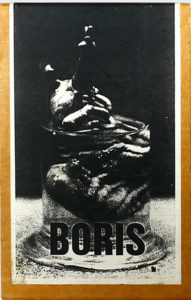
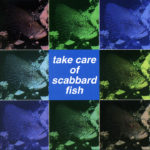

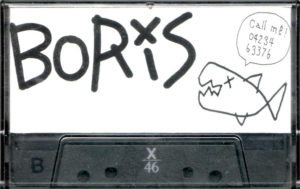
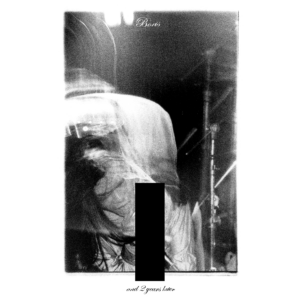
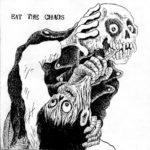
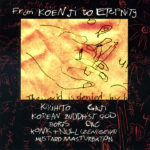
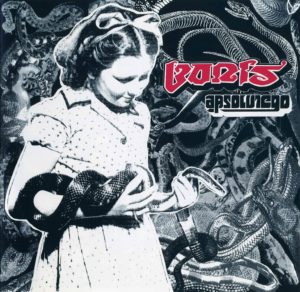
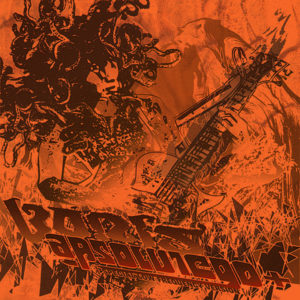
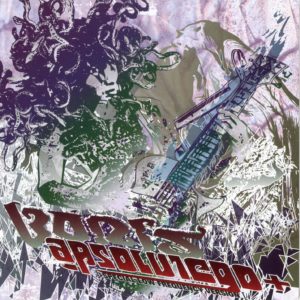
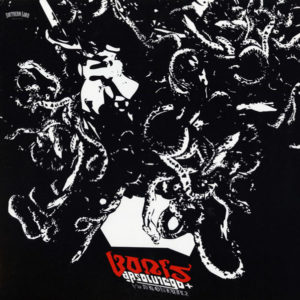
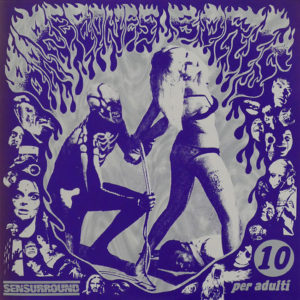
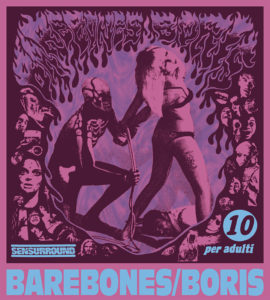
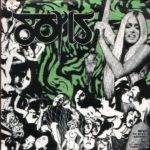
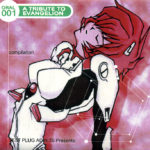
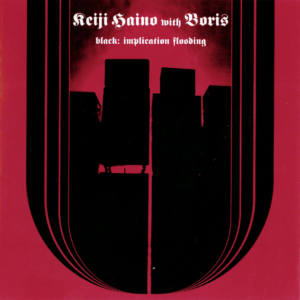
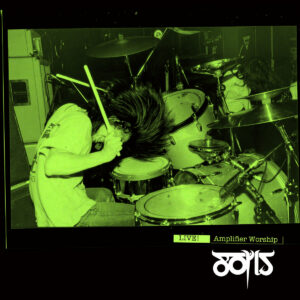
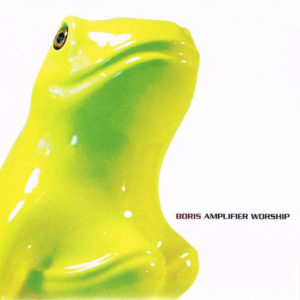
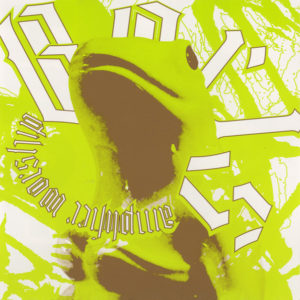
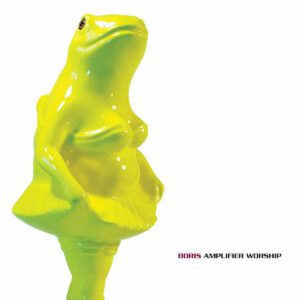
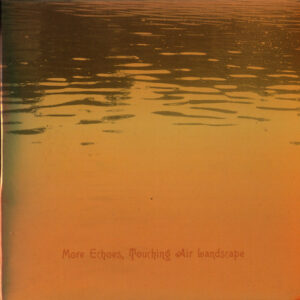

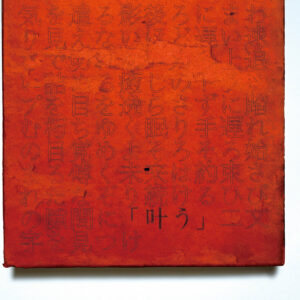
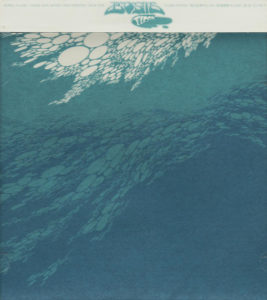
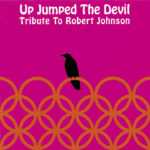

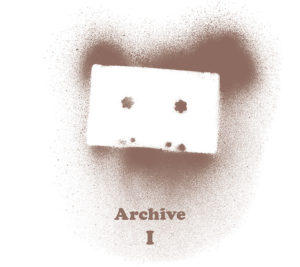
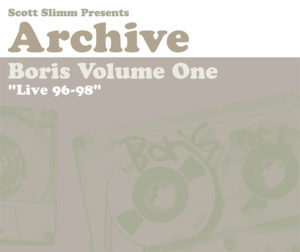

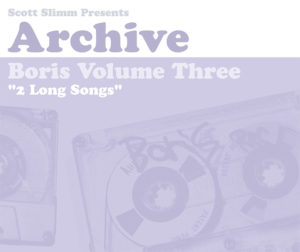
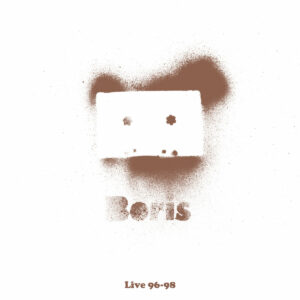
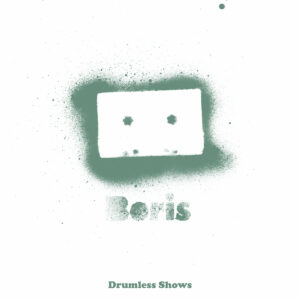


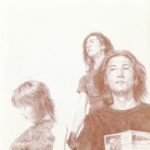
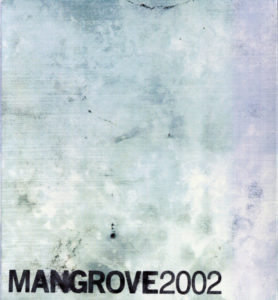
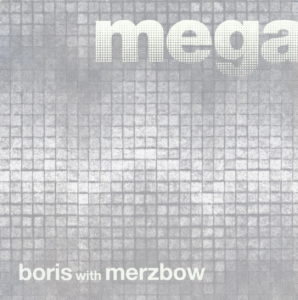
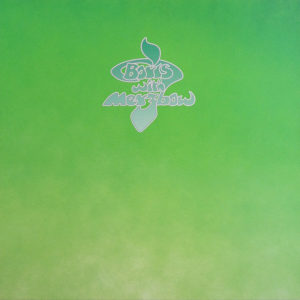

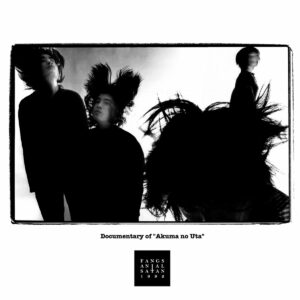
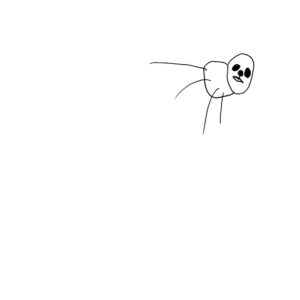
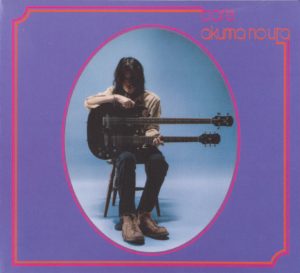
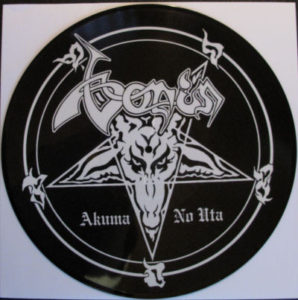
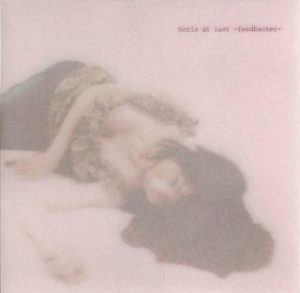
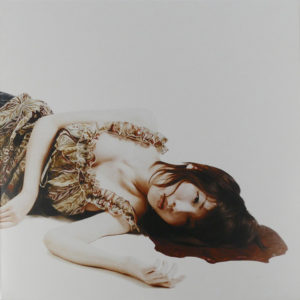
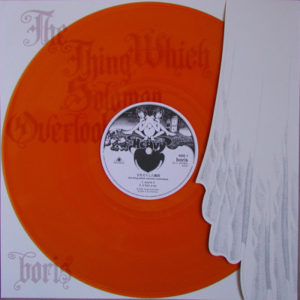
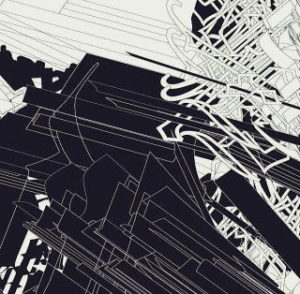
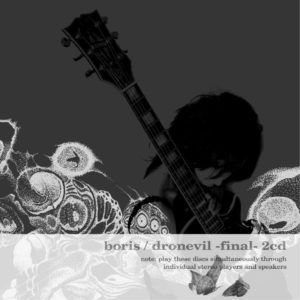
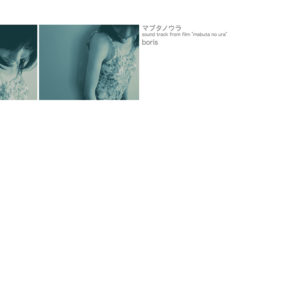
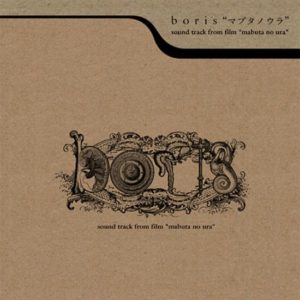
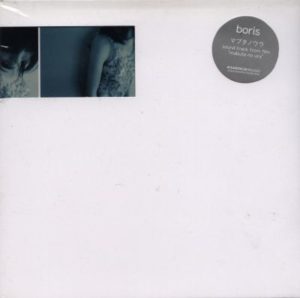
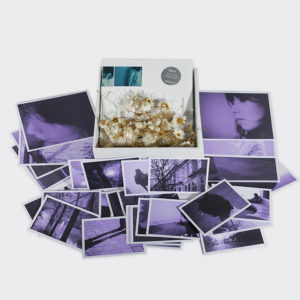
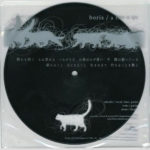


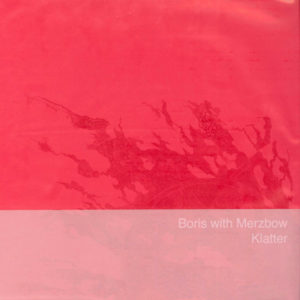
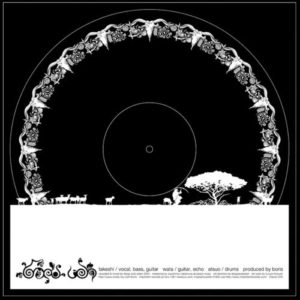
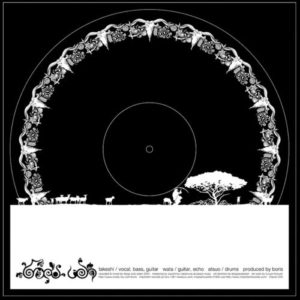
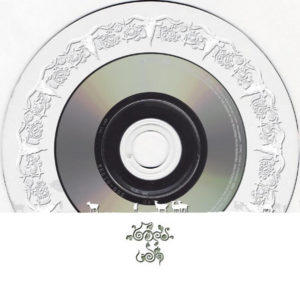

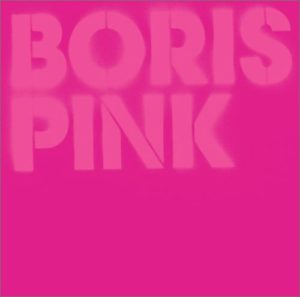
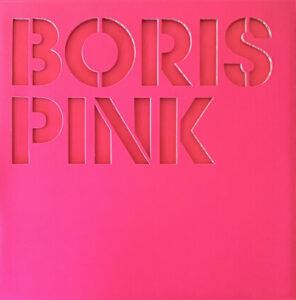

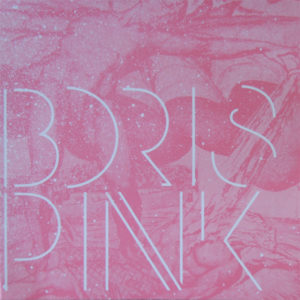
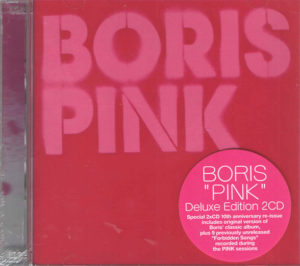
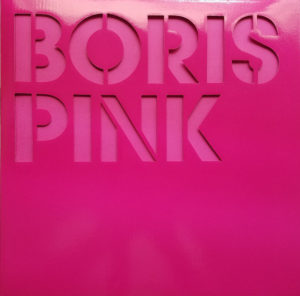
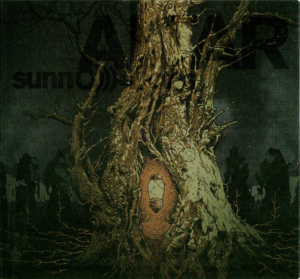
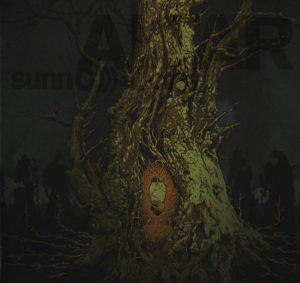
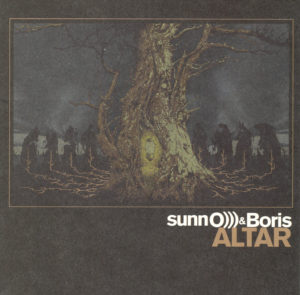
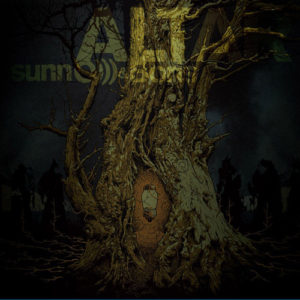
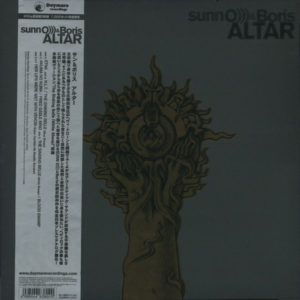
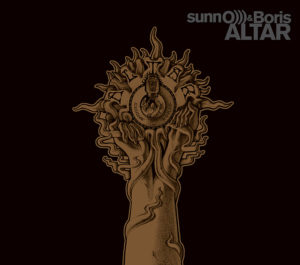
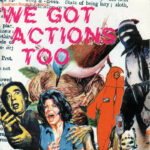
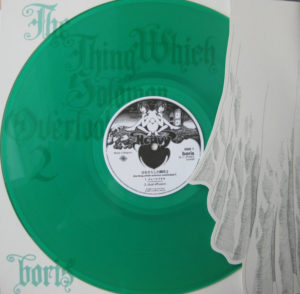
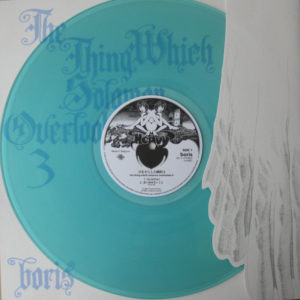
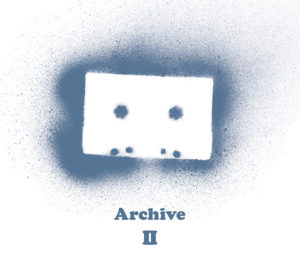
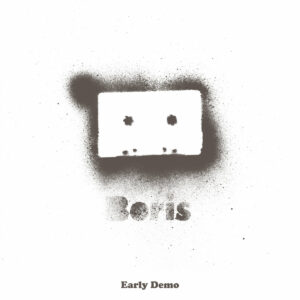
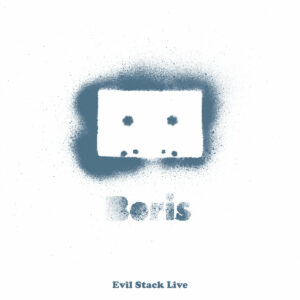
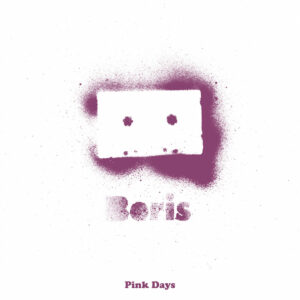


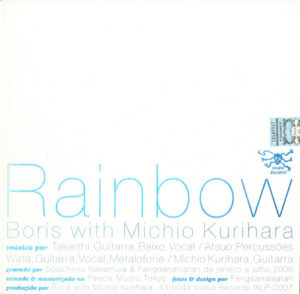
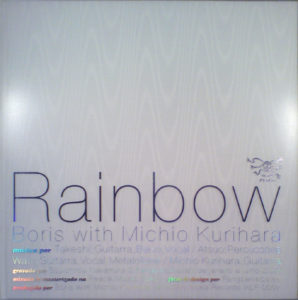
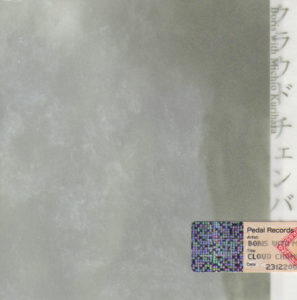
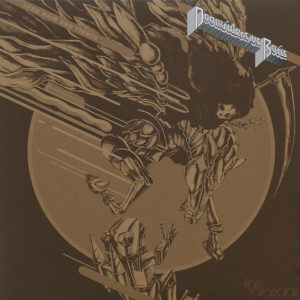
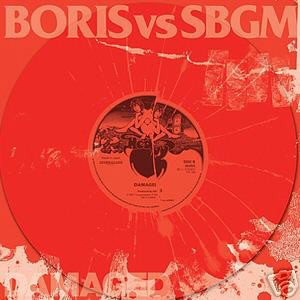
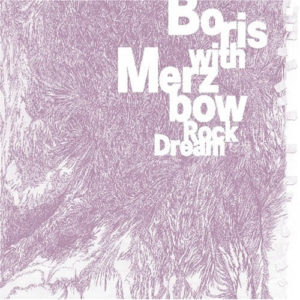
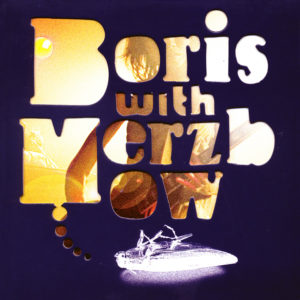
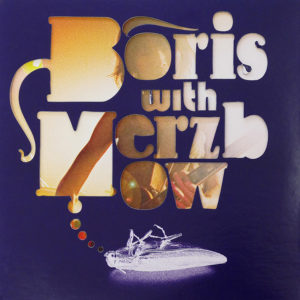
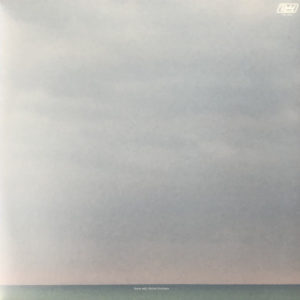

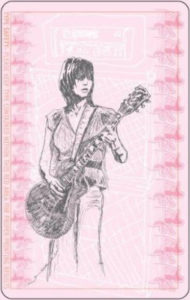
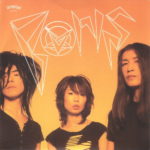


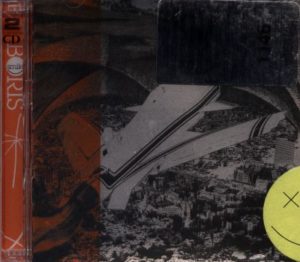
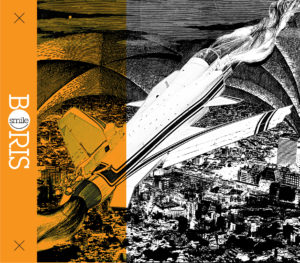

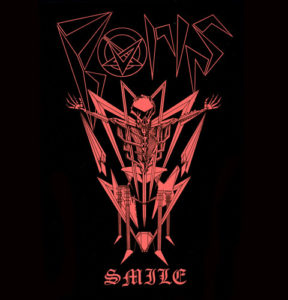
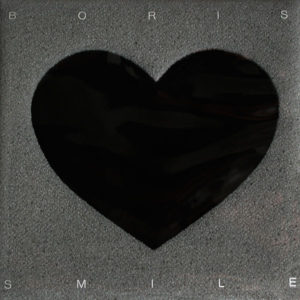
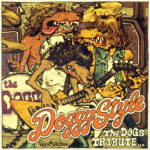
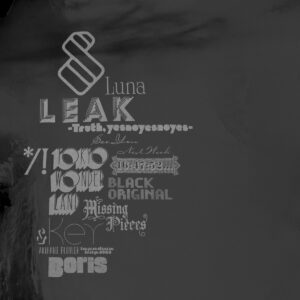

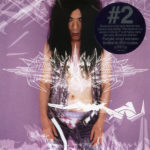

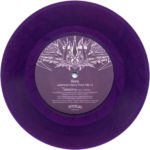
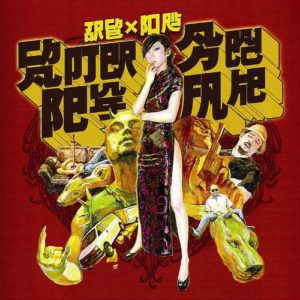
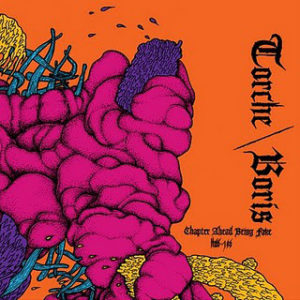
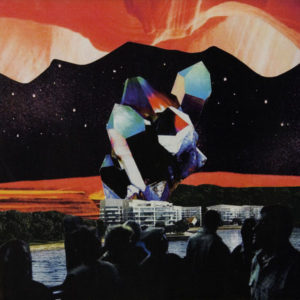
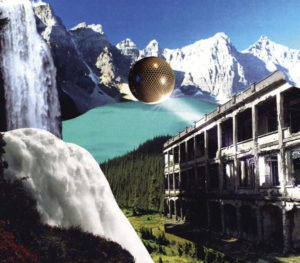
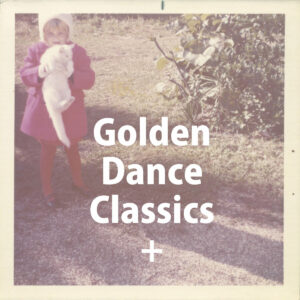
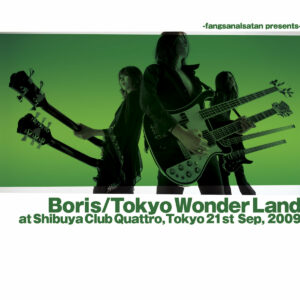
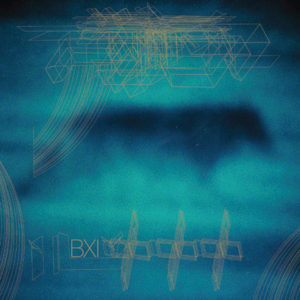
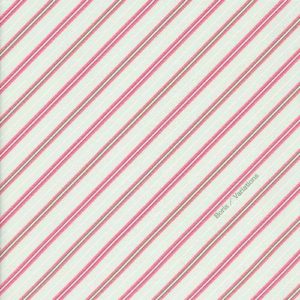
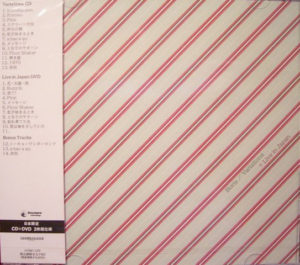
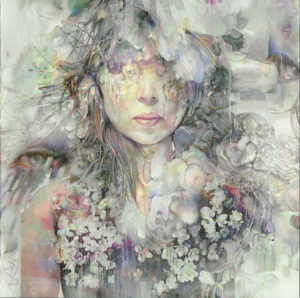
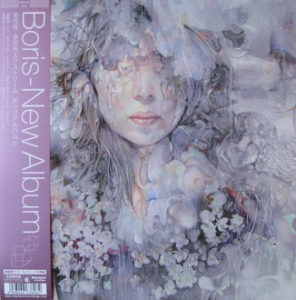




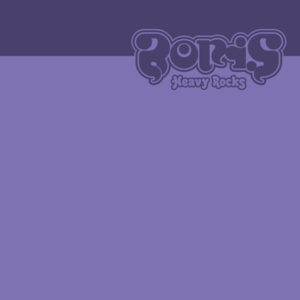
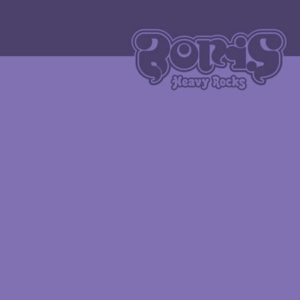
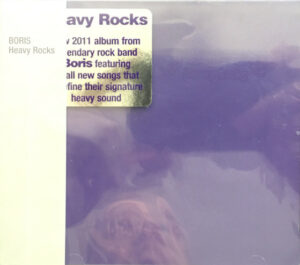
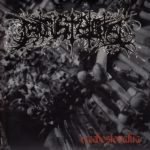
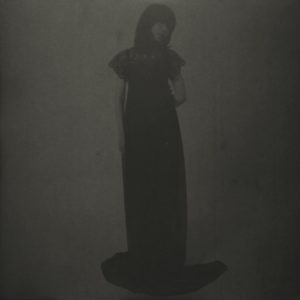
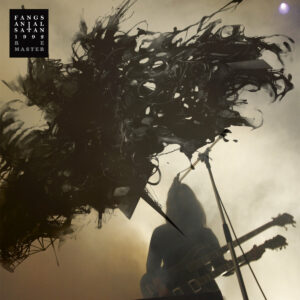
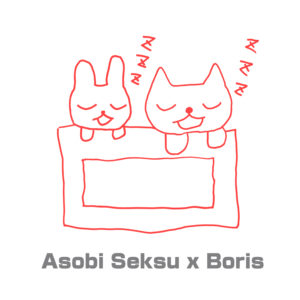
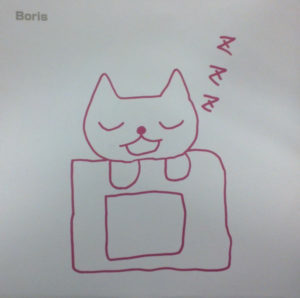
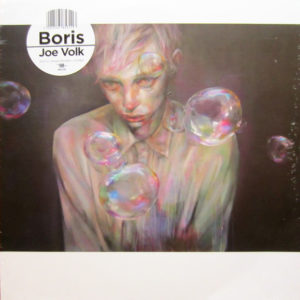
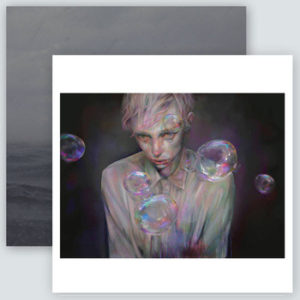


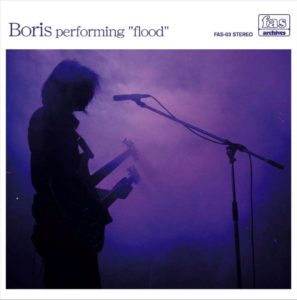
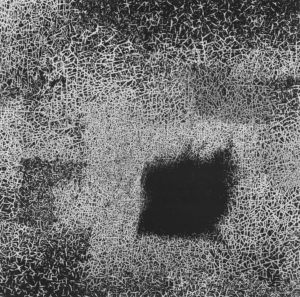
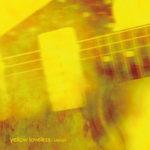
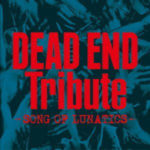
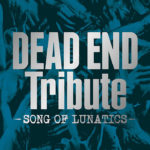
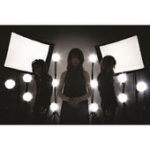
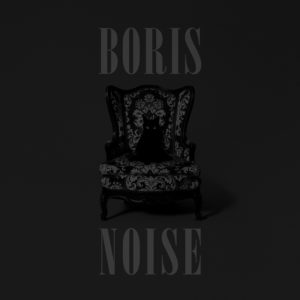
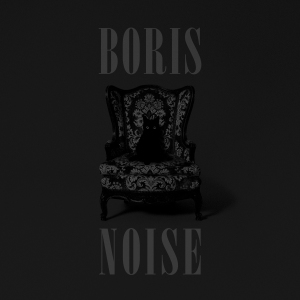
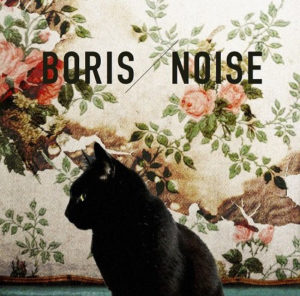
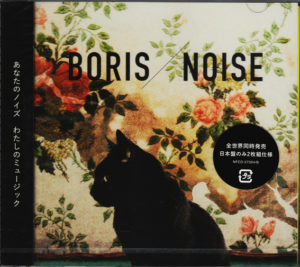

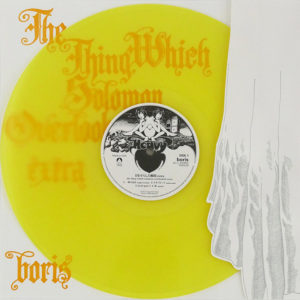
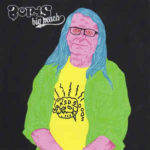
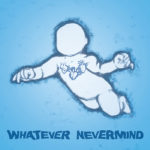
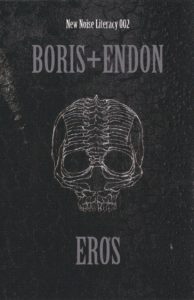
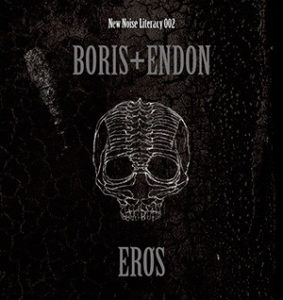
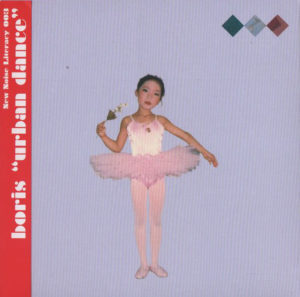
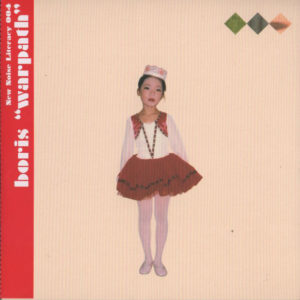
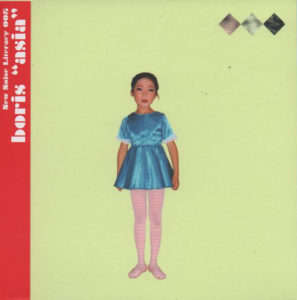
![ニンジャスレイヤー フロムコンピレイション「忍」 [Ninja Slayer Nin]](http://rocksalted.com/wp-content/uploads/2018/10/2015_ninjaslayer_nin_CD-150x150.jpg)
![ニンジャスレイヤー フロムコンピレイション「殺」 [ Ninja Slayer Satsu]](http://rocksalted.com/wp-content/uploads/2018/10/2016_ninjaslayer_satsu_CD-150x150.jpg)
